Screener and Survey for Online Participants (content is
CDC and ATSDR Health Message Testing System
4- APPENDIX B- Materials for online survey with mothers - DNPAO Message ...
Message Testing with Mothers for CDC's Division of Nutrition, Physical Activity, and Obesity (DNPAO)
OMB: 0920-0572
APPENDIX B:
MATERIALS FOR ONLINE SURVEY WITH MOTHERS
Table of Contents
|
Page Number |
|
1 |
|
9 |
|
24 |
Survey Screener
Survey Screener for Mothers
Message Testing for CDC’s Division of Nutrition, Physical Activity and Obesity
Introduction
SHOW: Thank you for your interest in participating in this survey about health information. There are two steps to participating:
Step 1: Screener
First, you will be asked a few screening questions to help us know if you qualify to participate in the survey.
These screening questions will take you about 3 minutes to complete.
If you qualify to participate, you will be able to move on to take the online survey (step 2 below).
Step 2: Online Survey
In the online survey, you will see some statements, messages, or ideas. You will then be asked to share your honest opinions about them.
The online survey will take you about 12 minutes to complete.
A few other things you should know:
You have the option to not participate.
Answering the screening questions and participating in the survey is completely voluntary.
You may stop participating at any time.
Your responses will be entered into a database. They will be combined with the responses of other participants.
Only the researchers working with this online survey will be able to see the responses.
Your answers will be kept secure to the extent permitted by law.
There will be no risk to you.
You will receive your incentive after completing the online survey according to your panel arrangement
If you have any questions about this online survey or about your rights as an online survey participant, please email them to [email protected].
By clicking 'Continue,' I agree that I understand the project description above and want to continue to step 1.
Public Reporting Burden Statement
Public reporting burden of this collection of information is estimated to be approximately 3 minutes per response, including the time for reviewing instructions, searching existing data sources, gathering and maintaining the data needed, and completing and reviewing the collection of information. An agency may not conduct or sponsor, and a person is not required to respond to a collection of information unless it displays a currently valid OMB control number. Send comments regarding this burden estimate or any other aspect of this collection of information, including suggestions for reducing this burden to CDC/ATSDR Information Collection Review Office, 1600 Clifton Road NE, MS D-74, Atlanta, Georgia 30333; ATTN: PRA (0920-0572).
GENERAL SCREEN OUT MESSAGE UNLESS OTHERWISE NOTED:
Thank you for answering these questions. Unfortunately, you do not qualify for this online survey, or we have already reached the limit of participants with responses similar to yours. We appreciate your interest in our online survey. We hope you will join us on future online surveys!
Screening Criteria
S1. Do you, or does any member of your household or immediate family work…? SINGLE RESPONSE GRID FORMAT, RANDOMIZE LIST.
1 Yes
2 No
For a market research company
For an advertising agency or public relations firm
For the media (TV, radio, newspapers, or magazines)
As a healthcare professional (doctor, nurse, pharmacist, dietician, etc.)
Banking and financial services
Software design or development
Law enforcement
IF RESPONSE 1 TO ANY OF S1A-D, SCREEN OUT.
S2. Are you…? SINGLE RESPONSE, DO NOT ROTATE.
1 Male SCREEN OUT
2 Female
S3 . How old are you? NUMERIC OPEN END, SCREEN OUT IF YOUNGER THAN 25 OR OLDER THAN 49. INCLUDE A CHECKBOX FOR “PREFER NOT TO ANSWER,” AND SCREEN OUT IF THAT BOX IS CHOSEN.
SHOW S4-S6 ON THE SAME SCREEN.
S4. What state do you live in? INSERT ALPHABETICAL LIST OF STATES AS A DROPDOWN
S5. What is your zip code? ______________________ [ENTER VALID 5 DIGIT RANGE]
S6. Which of the following best describes the area where you live? SINGLE RESPONSE, RANDOMIZE LIST.
Urban
Suburban
Rural
S6_1. Macro Census Region – CODE ONLY – RESPONDENT WILL NOT SEE THIS
Northeast
South
Midwest
West
S6_2. Micro Census Region – CODE ONLY – RESPONDENT WILL NOT SEE THIS
1 New England
2 Mid Atlantic
3 South Atlantic
4 East South Central
5 East North Central
6 West South Central
7 West North Central
8 Mountain
9 Pacific
S6_3. MARKET SIZE – CODING ONLY, RESPONDENT WILL NOT SEE THIS
1 Top 10 Markets
2 Markets 11-20
3 Markets 21-50
4 Markets 51 to 100
5 Markets 101 plus
S6_4. COUNTY SIZE – CODING ONLY, RESPONDENT WILL NOT SEE THIS
A County
B County
C County
D County
S7. Which of the following statements best describes the language in which you prefer to read?
SINGLE RESPONSE GRID FORMAT, DO NOT ROTATE.
I only read in English
I am at least as comfortable reading in English as I am in another language
I prefer to read in a language other than English
IF S7=3, SCREEN OUT.
S8. Including yourself, how many people total, including both adults and children, live in your home? NUMERIC OPEN END. SCREEN OUT IF FEWER THAN 2.
S9. And how many children younger than 18 do you have living with you in your home? NUMERIC OPEN END, ALLOW ONLY WHOLE NUMBERS UP TO 10, SCREEN OUT IF ZERO.
S10. What are the ages of each of the children younger than 18 living with you in your home? Please give us whole numbers in years only. INSERT AS MANY CHILDREN AS CHOSEN IN S9. INSERT DROPDOWN FOR EACH CHILD WITH “LESS THAN 1 YEAR OLD,” “1 YEAR OLD,” “2 YEAR OLD,” ETC., UP TO “17 YEARS OLD.”
Child 1 ______ year(s) old
Child 2 ______ year(s) old
Child 3 ______ year(s) old
Child 4 ______ year(s) old
Child 5 ______ year(s) old
Child 6 ______ year(s) old
Child 7 ______ year(s) old
Child 8 ______ year(s) old
Child 9 ______ year(s) old
Child 10 ______ year(s) old
IF ZERO CHILDREN AGED 1 TO 8 SCREEN OUT. SEEK READABLE SAMPLE OF RESPONDENTS WITH ATLEAST ONE CHILD 1 TO 4 AND A READABLE SAMPLE OF RESPONDENTS WITH AT LEAST ONE CHILD 5 TO 8. OVERLAP IS EXPECTED.
S11. We would like to ask your approximate height and weight. Are you more comfortable answering in imperial measures (feet, inches, and pounds), or in metric measures (meters, centimeters, and kilos)? SINGLE RESPONSE.
Imperial measures (feet, inches, and pounds)
Metric measures (meters, centimeters, and kilos)
S12. Approximately how tall are you without shoes? NUMERIC OPEN END, ONLY SHOW THE MEASURE TYPE CHOSEN IN S11.
A Feet _____ Inches _____
B Meters _____ Centimeters _____
C Don‘t know / Not sure SCREEN OUT
D Prefer not to answer SCREEN OUT
S13. About how much do you weigh without shoes? NUMERIC OPEN END, ONLY SHOW THE MEASURE TYPE CHOSEN IN S11.
A Pounds _____
B Kilos _____
C Don‘t know / Not sure SCREEN OUT
D Prefer not to answer SCREEN OUT
CALCULATING BMI (FROM CDC WEBSITE)
FORMULA: [WEIGHT (LB) / [HEIGHT (IN)]2 X 703
Calculate BMI by dividing weight in pounds (lbs) by height in inches (in) squared and multiplying by a conversion factor of 703.
Example: Weight = 150 lbs, Height = 5'5" (65")
Calculation: [150 ÷ (65)2] x 703 = 24.96
S14. WEIGHT CLASS ACCORDING TO BMI - CODING ONLY, RESPONDENT WILL NOT SEE THIS
UNDERWEIGHT (<18.5 BMI)
NORMAL (18.5 BMI TO <25)
OVERWEIGHT (25 BMI TO <30)
CLASS 1 OBESE (30 BMI TO <35)
CLASS 2-3 OBESE (≥35+)
RESPONDENT BMI MUST FALL BETWEEN NORMAL AND CLASS-ONE OBESE (RESPONSE 2-4). SEEK A MINIMUM READABLE SAMPLE OF RESPONDENTS IN S14=2 AND S14=3-4.
FOR EACH BMI SEGMENT (S14=2 VS. S14=3+4), TARGET READABLE SAMPLES OF WITHIN EACH MACRO REGION (S6_1).
S15. Think about the most recent time you looked for health information from any source—such as the Internet, TV, radio, newspapers, or from a doctor or other health professional. This could include health information for yourself or related to your child/children. About how long ago was that? SINGLE RESPONSE, DO NOT ROTATE.
Days ago
Weeks ago
Months ago
Years ago
Never
IF S15=4 OR 5, SCREEN OUT.
S16. Please indicate where your family income falls before taxes. This is for your household’s total income from all sources before taxes. SINGLE RESPONSE
1 Less than $30,000 SCREEN OUT
2 $30,000 to $39,999
3 $40,000 to $49,999
4 $50,000 to $59,999
5 $60,000 to $69,999
6 $70,000 to $79,999 SCREEN OUT
7 $80,000 to $89,999 SCREEN OUT
8 $90,000 to $99,999 SCREEN OUT
9 $100,000 to $124,999 SCREEN OUT
10 $125,000 to $149,999 SCREEN OUT
11 $150,000 or more SCREEN OUT
12 Prefer not to answer SCREEN OUT
FOR EACH BMI SEGMENT (S14=2 VS. S14=3+4), TARGET READABLE SAMPLES OF LOWER HHI (S16=2-3) AND HIGHER HHI (S16=4-5).
S17. Please indicate your race or ethnic background. Are you….?
ETHNICITY (select one)
Hispanic or Latino
Not Hispanic or Latino
RACE (select one or more)
White
Black or African American
American Indian or Alaska Native
Native Hawaiian or Other Pacific Islander
Asian
SEEK A MIX OF ETHNICITIES.
S18. What is the highest level of education you have completed? SINGLE RESPONSE, DO NOT ROTATE.
Grade school
Less than high school graduate/some high school
High school graduate or completed GED
Some college or technical school
Received four-year college degree
Some post graduate studies
Received advanced degree
Prefer not to say SCREEN OUT
FOR EACH BMI SEGMENT (S14=2 VS. S14=3-4), TARGET READABLE SAMPLES OF FOUR YEAR COLLEGE GRADS (S18=5-7) AND NON-GRADS (S18=1-4).
S19. What is your marital status? SINGLE RESPONSE, DO NOT ROTATE.
Married
Living with a Significant Other
Divorced
Widowed
Separated
Single, never been married
Prefer not to say SCREEN OUT
S20. What is your current occupational status? Would you say…? SINGLE RESPONSE, DO NOT ROTATE.
Employed full time
Employed part time
Unemployed
Homemaker
Student
Retired
Disabled
Prefer not to say SCREEN OUT
S21 Have you ever breastfed? SINGLE RESPONSE, DO NOT ROTATE
Yes CONTINUE TO S22
No _END SURVEY________________
3 Prefer not to say SCREEN OUT
S22 If you have multiple children, respond to the following question regarding the youngest child.
How old was this child when s/he completely stopped breastfeeding or being fed breast milk? SINGLE RESPONSE, DO NOT ROTATE
1 day or less
1-7 days
2-3 weeks
1 month
2-5 months
6-11 months
1 year or more
I am still breastfeeding
9 Prefer not to say
Online Survey
Online Survey with Mothers
Introduction
SHOW: Thank you for completing step 1 by answering the screening questions. You are qualified to participate in this online survey. This survey is being conducted on behalf of the Centers for Disease Control and Prevention, sometimes referred to as CDC, in Atlanta.
Step 2: Online survey
In the online survey, you will see some statements, messages, or ideas. You will then be asked to share your honest opinions about them.
The online survey will take you about 12 minutes to complete.
A few other things you should know:
You have the option to not participate.
Answering the screening questions and participating in the survey is completely voluntary.
You may stop participating at any time.
Your responses will be entered into a database. They will be combined with the responses of other participants.
Only the researchers working with this online survey will be able to see the responses.
Your answers will be kept secure to the extent permitted by law.
There will be no risk to you.
You will receive your incentive after completing the online survey according to your panel arrangement
If you have any questions about this online survey or about your rights as an online survey participant, please email them to [email protected].
By clicking “continue,” I agree that I understand the project description above and want to continue to step 2 (the online survey).
Public Reporting Burden Statement
Public reporting burden of this collection of information is estimated to average 12 minutes per response, including the time for reviewing instructions, searching existing data sources, gathering and maintaining the data needed, and completing and reviewing the collection of information. An agency may not conduct or sponsor, and a person is not required to respond to a collection of information unless it displays a currently valid OMB control number. Send comments regarding this burden estimate or any other aspect of this collection of information, including suggestions for reducing this burden to CDC/ATSDR Information Collection Review Office, 1600 Clifton Road NE, MS D-74, Atlanta, Georgia 30333; ATTN: PRA (0920-0572).
ATTITUDES ABOUT OBESITY PREVENTION
please show the following message AT THE BOTTOM OF EACH SCREEN: “You can stop the survey at any time and return to this point in the survey simply by clicking on the original survey link.”
Q1. For each of the words and phrases below, please tell us what three words come to mind when you see them. PROVIDE THREE OPEN END BOXES FOR EACH PHRASE. RANDOMIZE ORDER OF PHRASES.
A Healthy, vibrant community _____ _____ _____
B Healthy weight _____ _____ _____
C Overweight _____ _____ _____
D Obesity _____ _____ _____
E Obesity prevention _____ _____ _____
Q2. Please indicate how much you agree or disagree with each of these statements. SINGLE RESPONSE, RANDOMIZE LIST.
Strongly disagree
Somewhat disagree
Neither agree nor disagree
Somewhat agree
Strongly agree
Preventing obesity is important to me.
Preventing obesity in my family is important to me.
Preventing obesity in my community is important to me.
Generally speaking, there are things that a person can do to reduce their risk for being overweight or obese.
Generally speaking, there are things that are out of a person’s control when it comes to reducing their risk for being overweight or obese.
I am confident that I can protect myself being overweight or obese.
I am confident that I can protect my children from being overweight or obese.
Q3. Which of the following statements best describes how you think the problem of obesity should be solved in your community? SINGLE RESPONSE, ROTATE 1-2.
Obesity is an individual problem that is best solved by people taking personal responsibility for what they eat and how physically active they are
Obesity is a community problem that is best solved by people working together to make it easier for everyone to eat healthy foods and be physically active
Obesity is both an individual and community problem that is best solved by people taking personal responsibility for what they eat and how physically active they are, and the community working together to make these behaviors easier to do
REACTIONS TO MESSAGES ABOUT RELATIONSHIP BETWEEN OBESITY AND NUTRITION AND PHYSICAL ACTIVITY
SHOW: “Now we will be showing you different messages or statements. After we show you each one, you will be asked some questions to get your reactions.”
SPLIT SAMPLE AND LOGIC INSTRUCTIONS
ASSIGN RESPONDENTS TO TWO MESSAGES TOTAL FROM THIS SECTION. EACH RESPONDENT WILL SEE EITHER MESSAGE 1 AND 2 OR MESSAGE 3 AND 4. MESSAGES SHOULD BE ASSIGNED RANDOMLY, WITH BUCKETS FILLED ACCORDING TO NEED.
EACH RESPONDENT WILL RESPOND TO Q5-Q9 WHILE SEEING EACH MESSAGE. KEEP MESSAGE ON SCREEN FOR EACH QUESTION.
EXPOSE RESPONDENTS TO MESSAGES IN A RANDOM ORDER.
Q4. MESSAGES ASSIGNED – CODING ONLY, RESPONDENT WILL NOT SEE THIS
MESSAGE #1
The key to achieving and maintaining a healthy weight isn’t about short-term dietary changes. It’s about a lifestyle that includes healthy eating, regular physical activity, and balancing the number of calories you consume with the number of calories your body uses.
Staying in control of your weight contributes to good health now and as you
age. By avoiding weight gain, you avoid higher risks of many chronic diseases,
such as heart disease, stroke, type 2 diabetes, high blood pressure,
osteoarthritis, and some forms of cancer.
MESSAGE #2
It can be difficult for children and parents to make healthy food choices and get enough physical activity when they are exposed to environments that do not support healthy habits. Places such as child care centers, schools, or communities can affect diet and activity through the foods and drinks they offer and the opportunities for physical activity they provide.
Other community factors that affect diet and physical activity include the affordability of healthy food options, peer and social supports, marketing and promotion, and policies that determine how a community is designed.
3 MESSAGE #3
As a parent, you can help shape your child's attitudes and behaviors toward physical activity. Throughout their lives, encourage young people to be physically active for one hour or more each day, with activities ranging from informal, active play to organized sports. Here are some ways you can do this:
Set a positive example by leading an active lifestyle yourself.
Make physical activity part of your family's daily routine by taking family walks or playing active games together.
Give your children equipment that encourages physical activity.
Take young people to places where they can be active, such as public parks, community baseball fields or basketball courts.
Be positive about the physical activities in which your child participates and encourage them to be interested in new activities.
Make physical activity fun. Fun activities can be anything your child enjoys, either structured or non-structured. Activities can range from team sports or individual sports to recreational activities such as walking, running, skating, bicycling, swimming, playground activities or free-time play.
Instead of watching television after dinner, encourage your child to find fun activities to do on their own or with friends and family, such as walking, playing chase or riding bikes.
Be safe! Always provide protective equipment such as helmets, wrist pads or knee pads and ensure that activity is age-appropriate.
4 MESSAGE #4
As a parent, you can help shape your child's attitudes and behaviors toward physical activity. Throughout their lives, encourage young people to be physically active for one hour or more each day, with activities ranging from informal, active play to organized sports. Here are some ways you can do this:
Set a positive example by leading an active lifestyle yourself.
Make physical activity part of your family's daily routine by taking family walks or playing active games together.
Give your children equipment that encourages physical activity.
Take young people to places where they can be active, such as public parks, community baseball fields or basketball courts.
Be positive about the physical activities in which your child participates and encourage them to be interested in new activities.
Make physical activity fun. Fun activities can be anything your child enjoys, either structured or non-structured. Activities can range from team sports or individual sports to recreational activities such as walking, running, skating, bicycling, swimming, playground activities or free-time play.
Instead of watching television after dinner, encourage your child to find fun activities to do on their own or with friends and family, such as walking, playing chase or riding bikes.
Be safe! Always provide protective equipment such as helmets, wrist pads or knee pads and ensure that activity is age-appropriate.
SHOW: “Please carefully read the following statement and then answer the questions that follow.’
[INSERT ASSIGNED MESSAGE. SHOW MESSAGE ON EVERY PAGE.]
Q5. How important to you is the information in this message? SINGLE RESPONSE, DO NOT ROTATE.
Not at all
Slightly
Moderately
Very
Extremely
SHOW Q6 AND Q6_1 ON THE SAME PAGE.
Q6. Is this message believable? SINGLE RESPONSE, DO NOT ROTATE.
Yes
2 No
Q6_1. Why or why not? OPEN END
Q7. Who would you say this message is trying to reach? Please check all that apply. MULTIPLE RESPONSE, DO NOT ROTATE.
You
People like you
Someone else
Q8. Please indicate how much you agree or disagree with each of the following statements about this message. SINGLE RESPONSE GRID FORMAT, RANDOMIZE LIST.
Strongly disagree
Somewhat disagree
Neither agree nor disagree
Somewhat agree
Strongly agree
Overall, I liked this message.
I am interested in the topic of this message.
I trust the information in this message.
This message was confusing.
This message was convincing.
This message got my attention.
I learned something new from this message.
I was offended by this message.
I can do what this message suggests.
Q9. How much did this message motivate you to…? SINGLE RESPONSE GRID FORMAT, RANDOMIZE LIST.
Not at all
Slightly
Moderately
Very
Extremely
Be more physically active yourself
Eat healthier yourself
Help your children be more physically active
Help your children to eat healthier
Look for more information on the health benefits for you and your family of being more physically active
Look for more information on the health benefits for you and your family of eating healthier
Talk to a friend or other family member about the health benefits of being more physically active
Talk to a friend or other family member about the health benefits of eating healthier
Participate in community efforts to reduce obesity
IF RESPONDENT HAS SEEN THE Q5-Q9 SERIES JUST ONCE, LOOP BACK TO SECOND ASSIGNED MESSAGE. WHEN RESPONDENT HAS SEEN THE Q5-Q9 SERIES TWICE (ONE FOR EACH ASSIGNED MESSAGE), CONTINUE TO Q10.
RANKING OF RELEVANT BELIEF/ATTITUDE STATEMENTS
Q10_1. Please read the list of statements below. Then, select the statements from the list that are most compelling to you when thinking about your children — in other words, the ones that speak the most to you. You can choose as many as three. MULTIPLE RESPONSE, ALLOW AS MANY AS THREE RESPONSES. RANDOMIZE LIST.
I would like my children to have a better life than me.
I want my children to grow into healthy adults.
I want to teach my children how to take care of themselves so they can live healthy lives.
I want to be a good example for my children so they know how to lead a healthy life.
I want my children to be happy and healthy.
I want my children to be physically and financially independent.
Q10_2. Please read the list of statements below. Then, select the statements from the list that are most compelling to you when thinking about your family— in other words, the ones that speak the most to you. You can choose as many as three. MULTIPLE RESPONSE, ALLOW AS MANY AS THREE RESPONSES. RANDOMIZE LIST.
I want my family to avoid getting chronic diseases like diabetes, cancer, and heart disease.
I want my neighborhood to be a place where my family has access to healthy foods.
I want my neighborhood to be a place where my family has access to places to be active.
I want my neighborhood to be a healthy and safe place for my family and me to live.
I want to save money for things that are important to my family. .
I want to feel good and be able to do the things my family enjoys.
I want everyone in my family to have along and healthy life.
Q10_3. Of the statements you marked as most compelling, please select the ones that speak to you the most. MULTIPLE RESPONSE, ALLOW AS MANY AS THREE RESPONSES. INSERT AND RANDOMIZE LIST OF STATEMENTS CHOSEN IN Q10_1 AND Q10_2.
[INSERT LIST HERE]
Q11. And which of these statements, if any, did not speak to you at all? Please choose as many as apply. MULTIPLE RESPONSE, RANDOMIZE LIST BUT REMOVE ANY ITEMS CHOSEN IN Q10.
[INSERT AND RANDOMIZE Q10 LIST AS APPROPRIATE]
MESSAGES RELATED TO POTENTIAL BELIEFS/ATTITUDES OF MOTHERS AS IT RELATES TO OBESITY PREVENTION/MAKING HEALTHY LIVING EASIER FOR THEIR FAMILIES
SHOW: “Now we have a few more messages or statements to show you. After we show you each one, you will be asked a few more questions to get your reactions.”
SPLIT SAMPLE AND LOGIC INSTRUCTIONS
ASSIGN RESPONDENTS TO THREE BELIEFS/ATTITUDES TOTAL FROM THIS SECTION. BELIEFS/ATTITUDES SHOULD BE ASSIGNED RANDOMLY, WITH BUCKETS FILLED ACCORDING TO NEED.
EACH RESPONDENT WILL RESPOND TO Q13-Q17 WHILE SEEING EACH BELIEF/ATTITUDE. KEEP BELIEF/ATTITUDE ON SCREEN FOR EACH QUESTION.
NOTE: SHOW RESPONDENTS THE MESSAGE FOR EACH BELIEF – NOT THE BELIEF ITSELF. (I.E., NOT THE BOLDFACE LANGAUGE, BUT THE LANGUAGE AFTER IT.)
EXPOSE RESPONDENTS TO BELIEFS/ATTITUDES IN A RANDOM ORDER.
Q12. BELIEFS/ATTITUDES ASSIGNED – CODING ONLY, RESPONDENT WILL NOT SEE THIS
I would like my children to have a better life than me [Message #5]
Childhood obesity is related to psychological problems such as anxiety and depression; low self-esteem and lower self-reported quality of life; and social problems such as bullying and stigma. Consuming a healthy diet and being physically active can help children grow as well as maintain a healthy weight throughout childhood.
Kids need nutrition from foods and drinks to fuel their bodies. The kinds and amounts of food they give their bodies can directly affect how they look and feel.
Also, active kids are better learners. Students who are physically active tend to have better grades, school attendance, cognitive performance (e.g., memory) and classroom behaviors (e.g., on-task behavior).
Staying active and eating well can help set your children up for success now and in the future.
I want my children to grow into healthy adults [Message #6]
Eating healthy and being physically active can help kids grow into healthy adults.
A poor diet and physical inactivity can lead to energy imbalance (e.g., eating more calories than your body uses) and can increase the risk of a child becoming overweight or obese.
Children who have obesity are more likely to become adults with obesity. Adult obesity is associated with an increased risk of a number of serious health conditions including heart disease, type 2 diabetes, and cancer.
I want my family to avoid getting chronic diseases like diabetes, cancer, and heart disease [Message #7]
Good nutrition and regular physical activity are essential to keeping current and future generations of Americans healthy. People who eat a healthy diet and get enough physical activity live longer and have fewer chronic diseases, such as type 2 diabetes, heart disease, obesity, and some forms of cancer.
I want my neighborhood to be a place where my family has access to healthy foods [Message #8]
It can be difficult for children and parents to make healthy food choices and get enough physical activity when they are exposed to environments that do not support healthy habits. Places such as child care centers, schools, or communities can affect diet and activity through the foods and drinks they offer and the opportunities for physical activity they provide. Other community factors that affect diet and physical activity include the affordability of healthy food options, peer and social supports, marketing and promotion, and policies that determine how a community is designed.
I want my neighborhood to be a place where my family has access to places to be active [Message #9]
It
can be difficult for children and parents to make healthy food
choices and get enough physical activity when they are exposed to
environments that do not support healthy habits. Places such as child
care centers, schools, or communities can affect diet and activity
through the foods and drinks they offer and the opportunities for
physical activity they provide. Other community factors that affect
diet and physical activity include the affordability of healthy food
options, peer and social supports, marketing and promotion, and
policies that determine how a community is designed.
I want my neighborhood to be a healthy and safe place for my family and me to live [Message #10]
It can be difficult for children and parents to make healthy food choices and get enough physical activity when they are exposed to environments that do not support healthy habits. Healthy neighborhoods are those designed and built to improve the quality of life for all people who live, work, worship, learn, and play within their borders – where every person is free to make choices amid a variety of healthy, available, accessible, and affordable options.
I want to save money for things that are important to me and my family [Message #11]
Eating unhealthy and not getting enough physical activity costs money!
Excess calorie intake and physical inactivity contribute to obesity. The medical costs for adults with obesity have been found to be $1,429 higher than those of normal weight.
I want to feel good and be able to do the things my family enjoys [Message #12]
People who eat a healthy diet and get enough physical activity live longer. By avoiding weight gain, you avoid higher risks of many chronic diseases, such as heart disease, stroke, type 2 diabetes, high blood pressure, osteoarthritis, and some forms of cancer.
I want to have a long healthy life [Message #13]
As a parent, you can help shape your child’s attitudes and behaviors toward physical activity and what they eat so they can make healthier choices for themselves as they get older.
For example, you can make physical activity part of your family’s daily routine by taking family walks or playing active games together. And, you can help children learn to be aware of what they eat by developing healthy eating habits, looking for ways to make favorite dishes healthier, and reducing calorie-rich temptations. Making fruit and vegetables available and easy to eat and limiting sugary drinks to special occasions can also help children develop healthy behaviors.
I want to teach my children how to take care of themselves [Message #14]
Children and adolescents should do 60 minutes (1 hour) or more of physical activity each day. Remember that children imitate adults. Start adding physical activity to your own daily routine and encourage your child to join you.
I want to be a good example for my children so they know how to lead a healthy life [Message #15]
Children and adolescents should do 60 minutes (1 hour) or more of physical activity each day. Remember that children imitate adults. Start adding physical activity to your own daily routine and encourage your child to join you.
I want my children to be happy and healthy [Message #16]
Obesity during childhood can have a harmful effect on the body in a variety of ways. Childhood obesity is related to:
Psychological problems such as anxiety and depression.
Low self-esteem and lower self-reported quality of life.
Social problems such as bullying and stigma.
And, children who have obesity are more likely to have:
High blood pressure and high cholesterol, which are risk factors
for cardiovascular disease (CVD).
Increased risk of impaired glucose tolerance, insulin resistance,
and type 2 diabetes.
Breathing problems, such as asthma and sleep apnea.
Joint problems and musculoskeletal discomfort.
Fatty liver disease, gallstones, and gastro-esophageal reflux (i.e.,
heartburn).
I want my children to be physically and financially independent [Message #17]
Children who have obesity are more likely to become adults with obesity. Adult obesity is associated with increased risk of a number of serious health conditions including heart disease, type 2 diabetes, and cancer. If children have obesity, their obesity and disease risk factors in adulthood are likely to be more severe. The medical costs for adults with obesity were $1,429 higher than those of normal weight. Also, obese adults are more likely to be discriminated against during the hiring process and perceived as having less leadership potential which could lead to greater risk of unemployment.
SHOW: “Please carefully read the following statement and then answer the questions that follow.’
[INSERT ASSIGNED MESSAGE. SHOW MESSAGE ON EVERY PAGE.]
Q13. How important to you is the information in this message? SINGLE RESPONSE, DO NOT ROTATE.
Not at all
Slightly
Moderately
Very
Extremely
Q14. Is this message believable? SINGLE RESPONSE, DO NOT ROTATE.
Yes
2 No
Q15. Who would you say this message is trying to reach? Please check all that apply. MULTIPLE RESPONSE, DO NOT ROTATE.
You
People like you
Someone else
Q16. Please indicate how much you agree or disagree with each of the following statements about this message. SINGLE RESPONSE GRID FORMAT, RANDOMIZE LIST.
Strongly disagree
Somewhat disagree
Neither agree nor disagree
Somewhat agree
Strongly agree
Overall, I liked this message.
I am interested in the topic of this message.
I trust the information in this message.
This message was confusing.
This message was convincing.
This message got my attention.
I learned something new from this message.
I was offended by this message.
I can do what this message suggests.
Q17. How much did this message motivate you to…? SINGLE RESPONSE GRID FORMAT, RANDOMIZE LIST.
Not at all
Slightly
Moderately
Very
Extremely
Be more physically active yourself
Eat healthier yourself
Help your children be more physically active
Help your children to eat healthier
Look for more information on the health benefits for you and your family of being more physically active
Look for more information on the health benefits for you and your family of eating healthier
Talk to a friend or other family member about the health benefits of being more physically active
Talk to a friend or other family member about the health benefits of eating healthier
Participate in community efforts to reduce obesity
IF RESPONDENT HAS SEEN THE Q13-Q17 SERIES JUST ONCE OR TWICE, LOOP BACK TO THE NEXT ASSIGNED MESSAGE. WHEN RESPONDENT HAS SEEN THE Q13-Q17 SERIES THREE TIMES (ONE FOR EACH ASSIGNED MESSAGE), FINISH SURVEY.
MESSAGES RELATED TO BREASTFEEDING
SHOW: “We are almost done. We would now like to get your reactions to a few more messages or
statements that specifically relate to breastfeeding. After we show you each
one, you will be asked a few questions to get your reactions.”
SPLIT SAMPLE AND LOGIC INSTRUCTIONS
ASSIGN RESPONDENTS TO TWO BREASTFEEDING MESSAGES TOTAL FROM THIS SECTION, ONE FROM MESSAGES 1-5 AND ONE FROM MESSAGES 6-7. THEY SHOULD BE ASSIGNED RANDOMLY.
EACH RESPONDENT WILL RESPOND TO Q18-Q19 WHILE SEEING THE MESSAGE. KEEP MESSAGE ON SCREEN FOR EACH QUESTION.
EXPOSE RESPONDENTS TO MESSAGES IN A RANDOM ORDER.
SHOW: “Please carefully read the following statement and then answer the questions that follow.’
[Breastfeeding protects babies - messages]
1 Breastfeeding protects babies. Breastfeeding is recognized as the best source of nutrition
for most infants. The cells, hormones, and antibodies in breastmilk help protect babies from illness. A few of the things that breastfed babies have includes a lower risk for are asthma, leukemia, obesity, ear infections, and type 2 diabetes. [Message #18]
2 Breastfeeding protects babies. Breastfeeding is recognized as the best source of nutrition
for most infants. Breastfeeding helps develop the parts of the brain responsible for language, emotions, thinking and learning. [Message #19]
3 Breastfeeding protects babies. Breastfeeding is recognized as the best source of
nutrition for most infants. Exclusive breastfeeding for six months helps prevent infant
deaths. [Message #20]
4 Breastfeeding protects babies. Breastfeeding is recognized as the best source of
nutrition for most infants. Medical costs may be lower for fully breastfed infants because breastfed infants usually need fewer sick care visits, prescriptions, and hospitalizations. [Message #21]
5 Breastfeeding protects babies. Breastfeeding is recognized as the best source of
nutrition for most infants. The longer the baby is breastfed, the greater the benefit. [Message #22]
[Breastfeeding benefits mothers - messages]
6 Breastfeeding benefits mothers. Breastfeeding helps a mother's health and healing
following childbirth. [Message #22]
7 Breastfeeding benefits mothers. Breastfeeding reduces the mother’s risk of breast and
ovarian cancer, type 2 diabetes, heart disease and stroke later in life. [Message #23]
Q18. Is this message believable? SINGLE RESPONSE, DO NOT ROTATE.
Yes
2 No
Q18_1. Why or why not? OPEN END
Q19. Please indicate how much you agree or disagree with each of the following statements about this message. SINGLE RESPONSE GRID FORMAT, RANDOMIZE LIST.
Strongly disagree
Somewhat disagree
Neither agree nor disagree
Somewhat agree
Strongly agree
Overall, I liked this message.
I am interested in the topic of this message.
I trust the information in this message.
This message was confusing.
This message was convincing.
This message got my attention.
I learned something new from this message.
I was offended by this message.
SHOW: That is the last question. Thank you for your time. Please click “OK” to confirm your participation.
Screenshots of Screener and Survey Questions/Messages to be Shown on Screen (as will be seen on the online survey platform by participants)
[Mothers will take part in an online survey. Prior to taking the survey, potentially eligible participants will complete an online screening questionnaire to confirm their eligibility. Once confirmed, participants will continue to the survey questions. Before taking the survey, the first screen will include consent language. Proceeding to take the survey will be confirmation that they have read the consent language and agree to participate
In the pages that follow, the screener and survey (as will be seen by participants on their computer screen) are presented below.]
A. Screenshots of Survey Screener
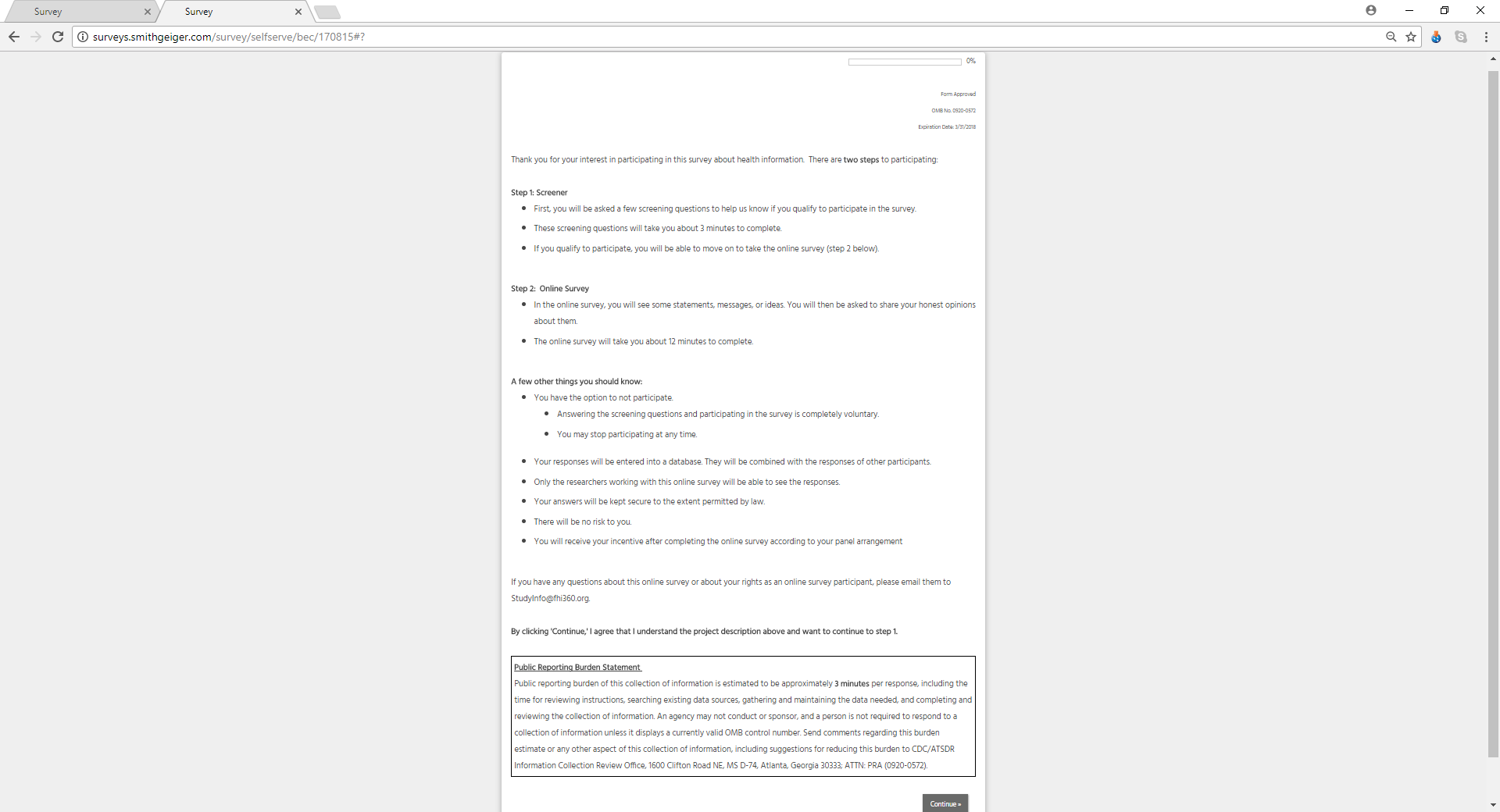
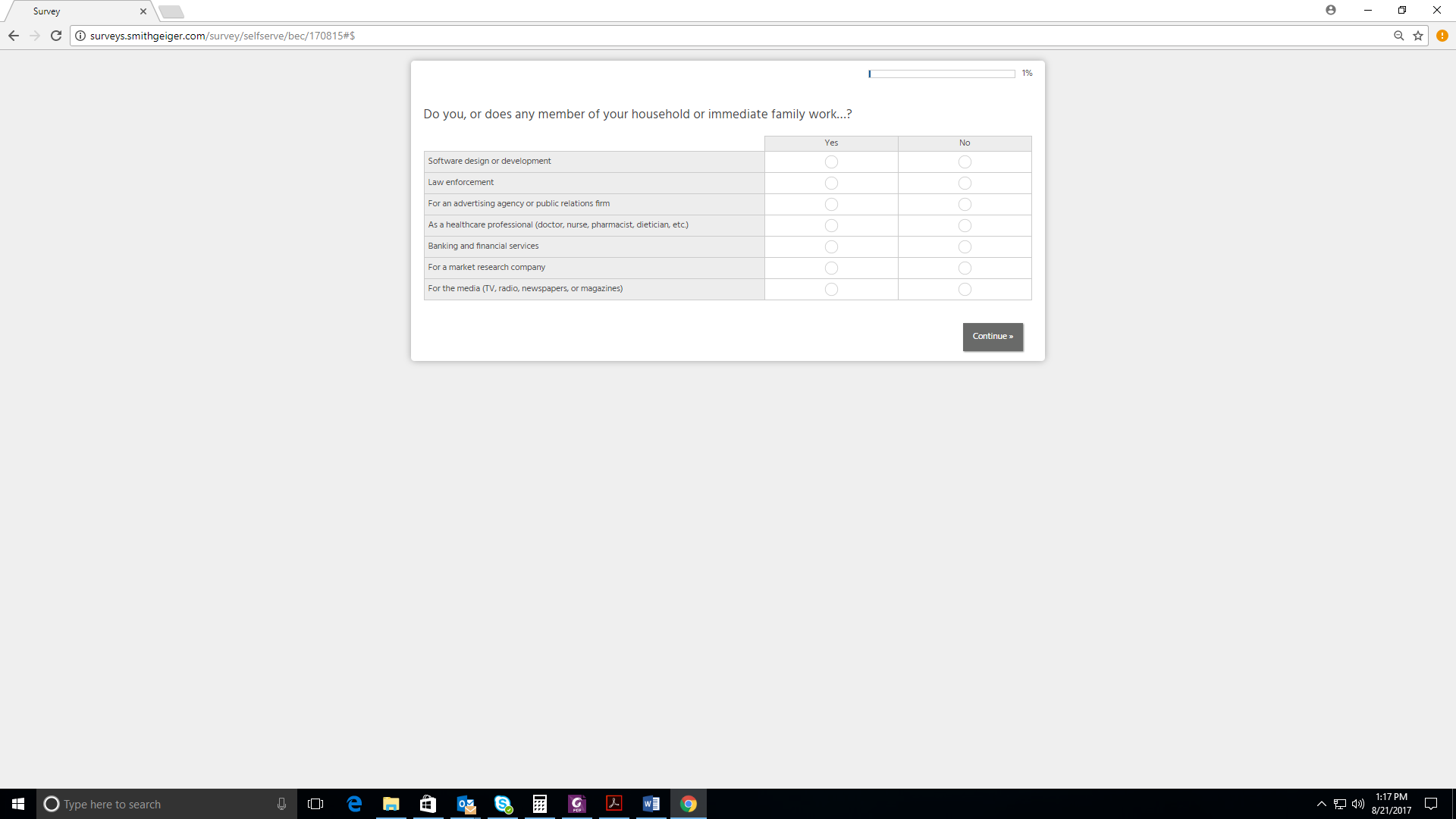


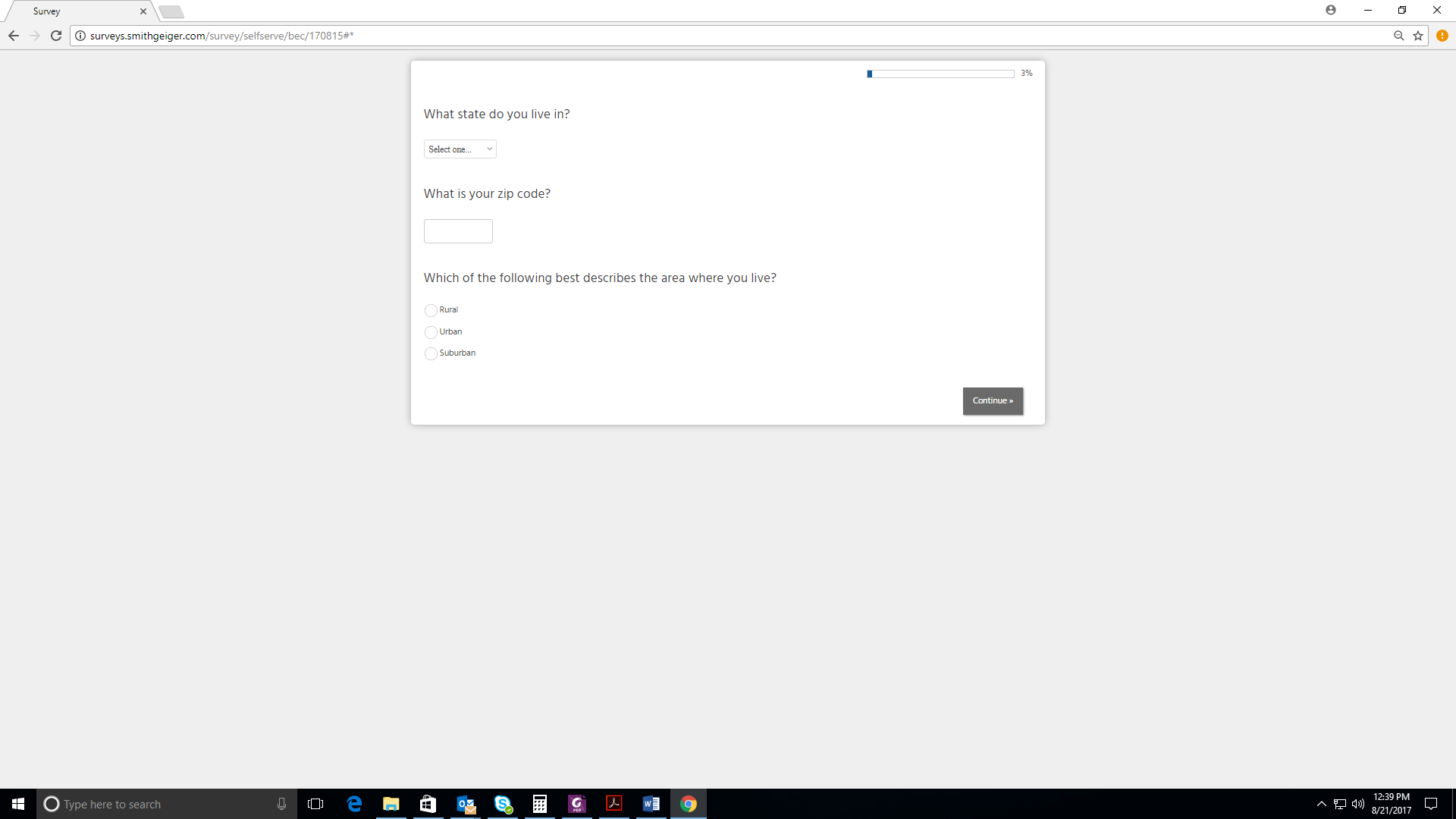







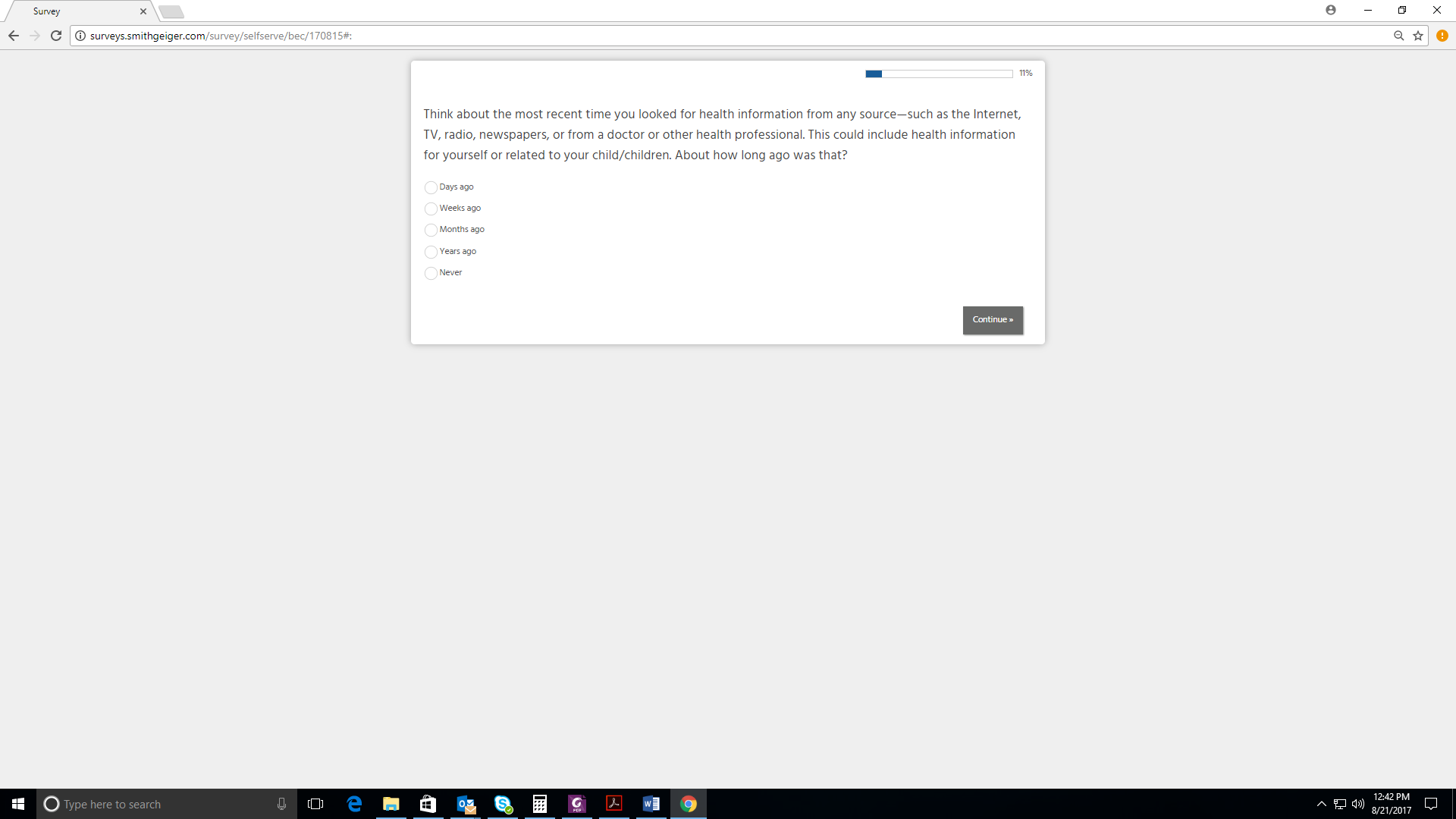






B. Screenshots of Online Survey
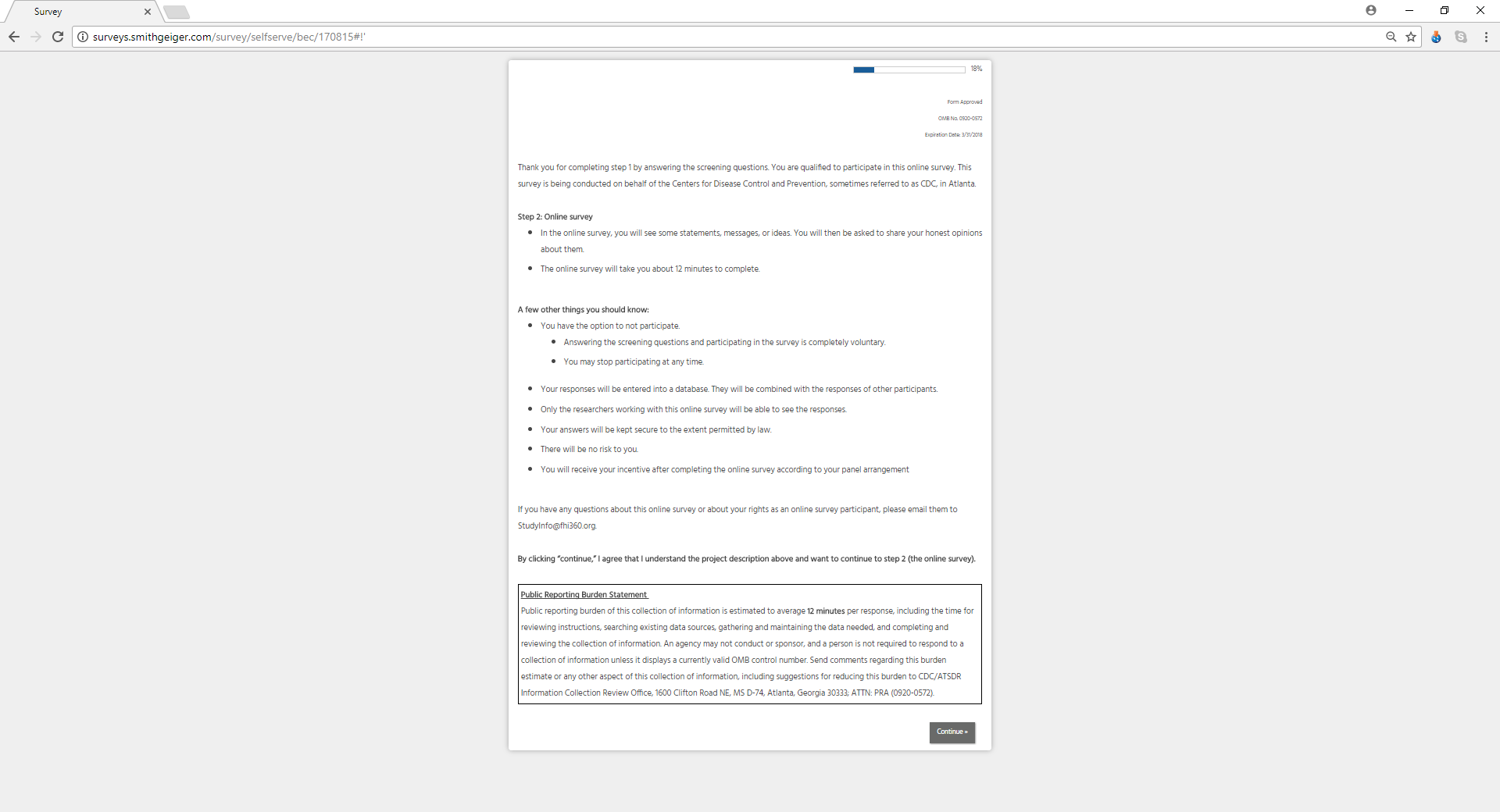
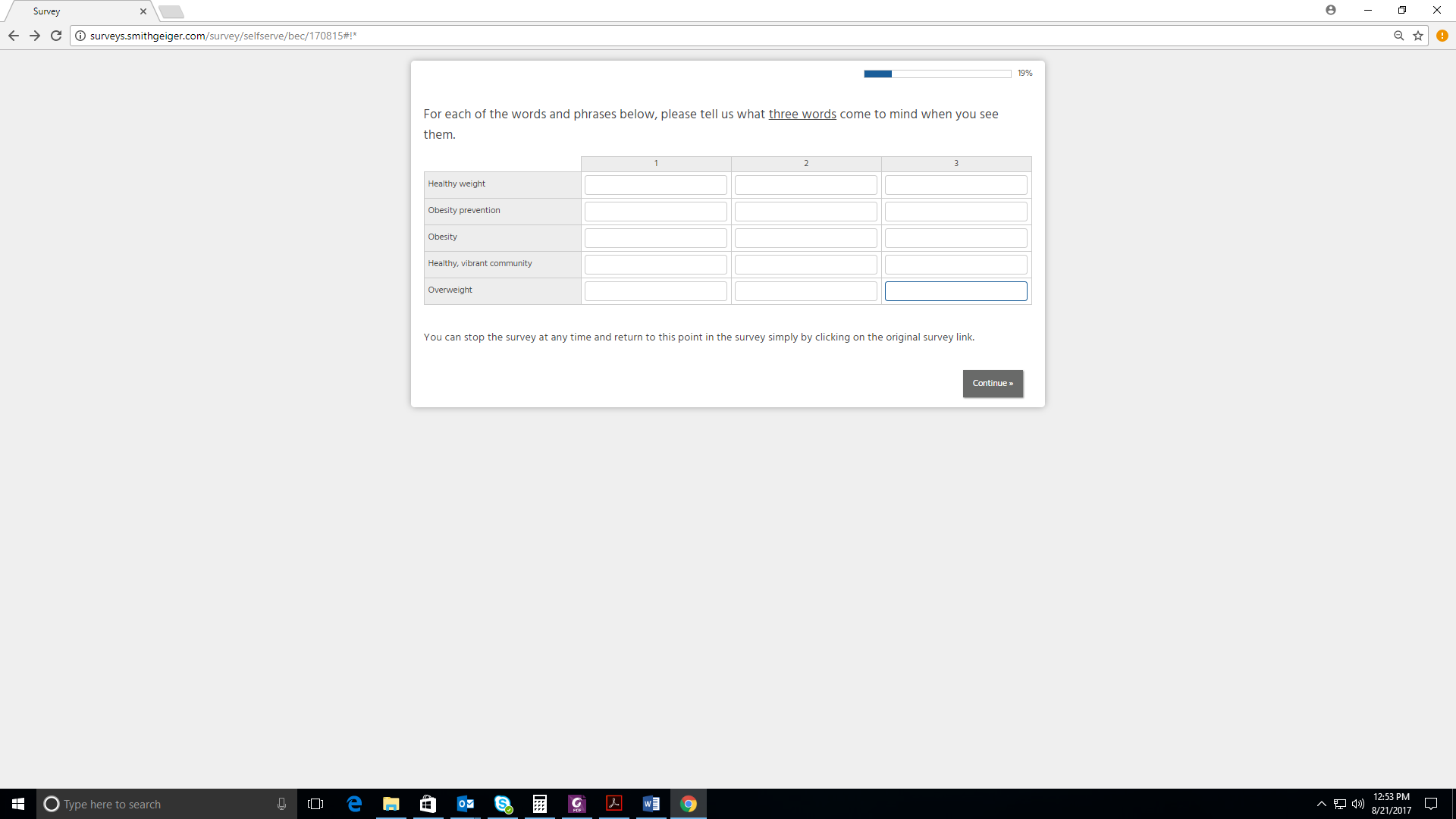
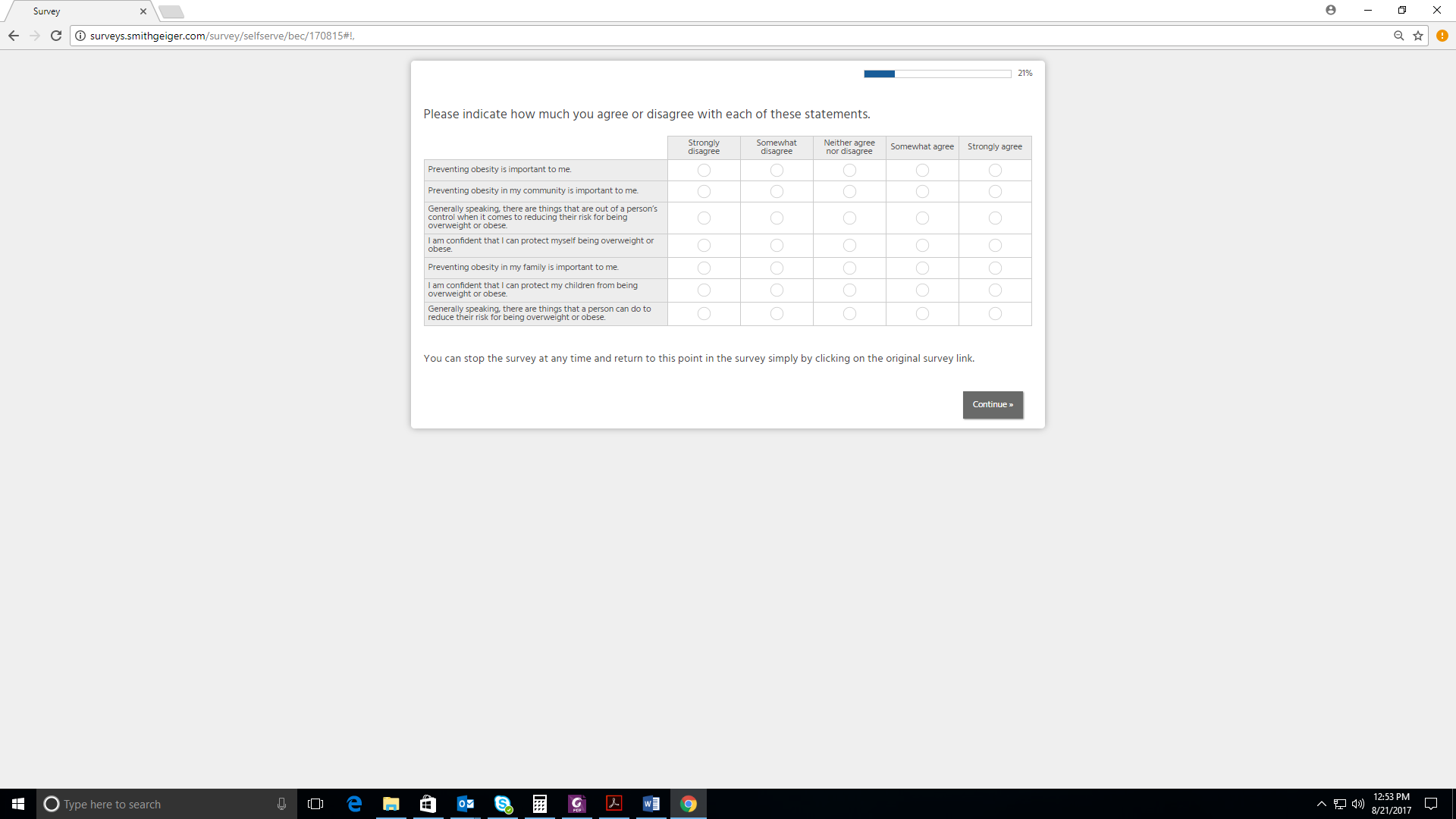


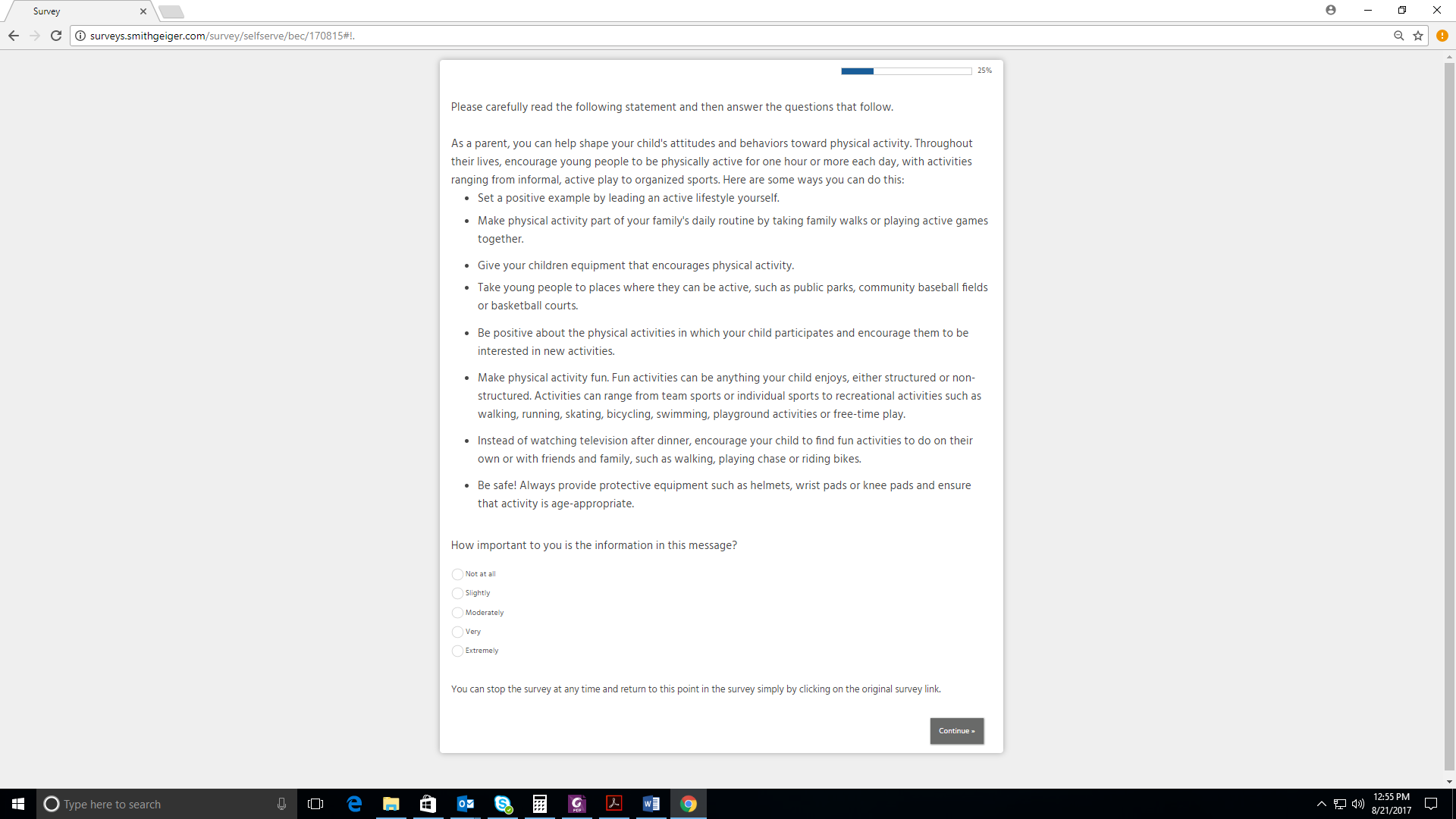
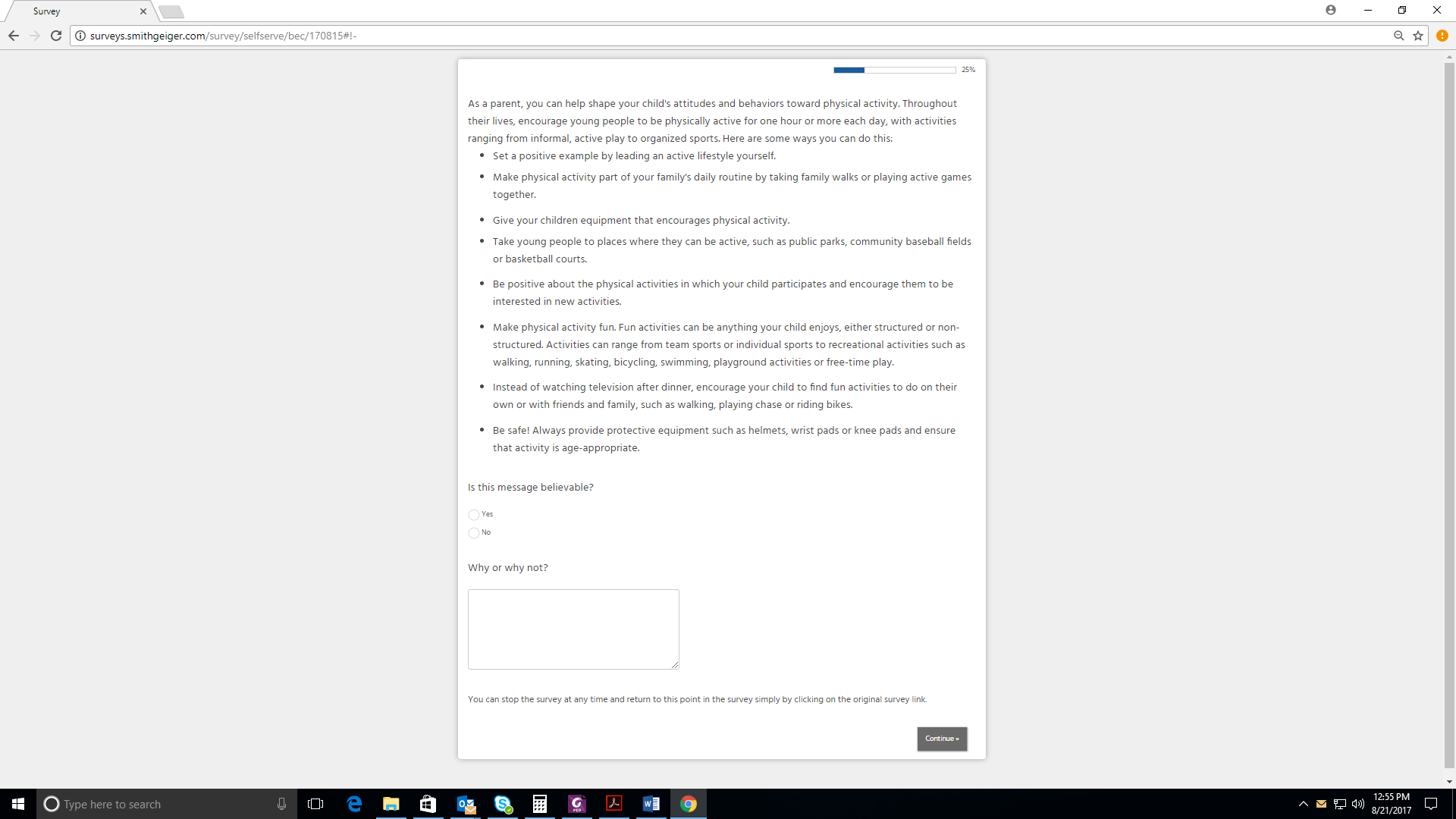
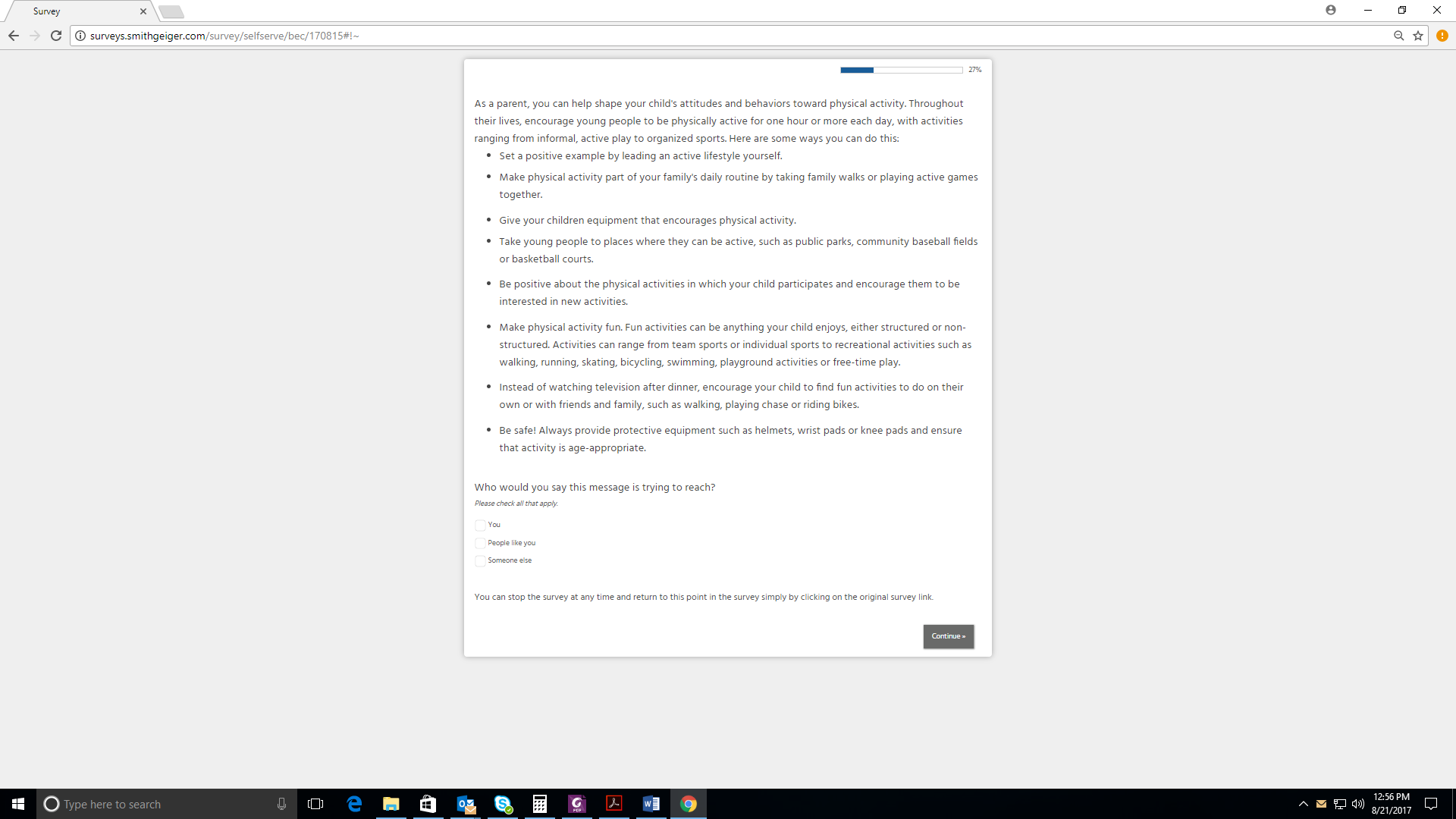
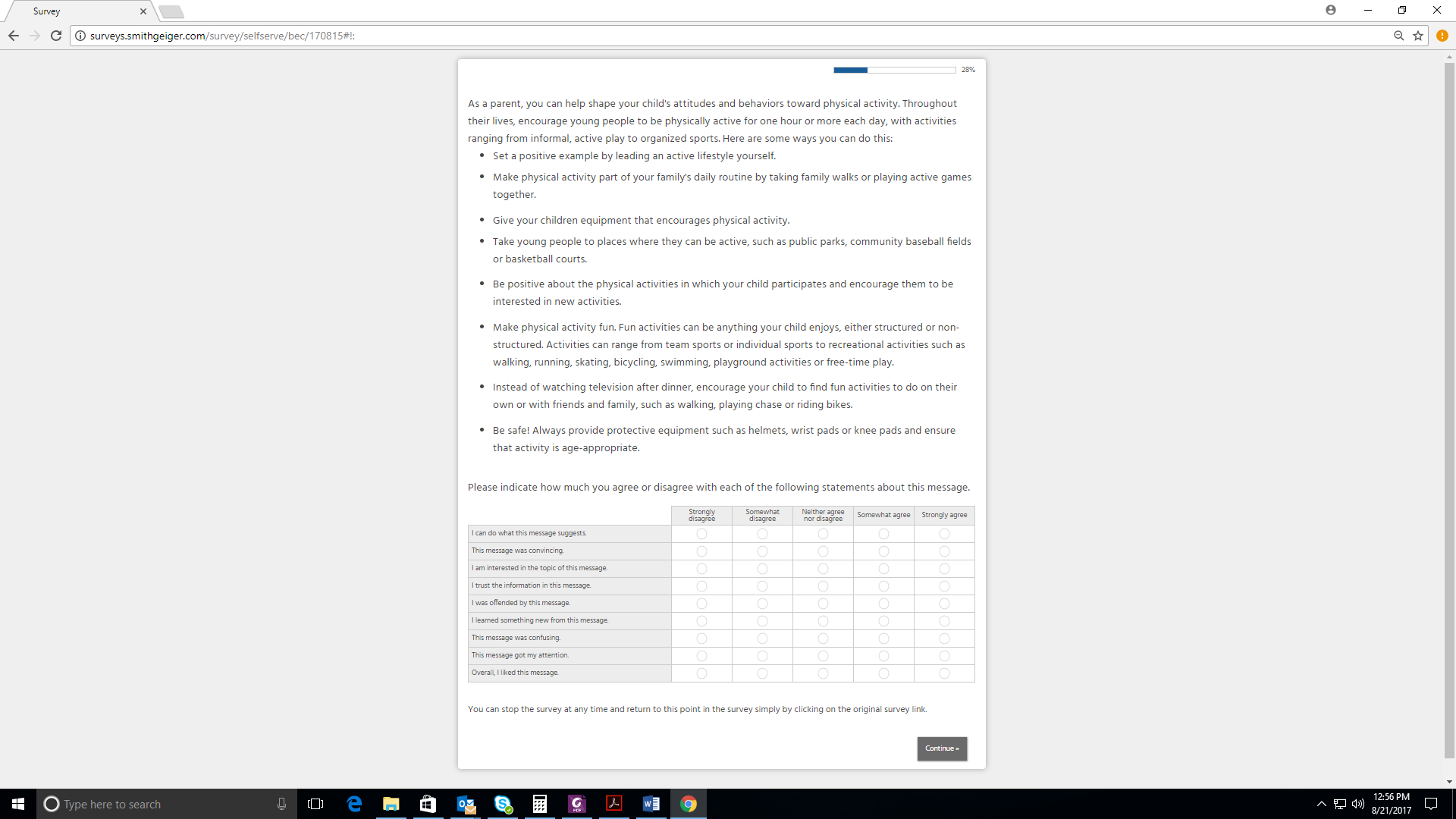
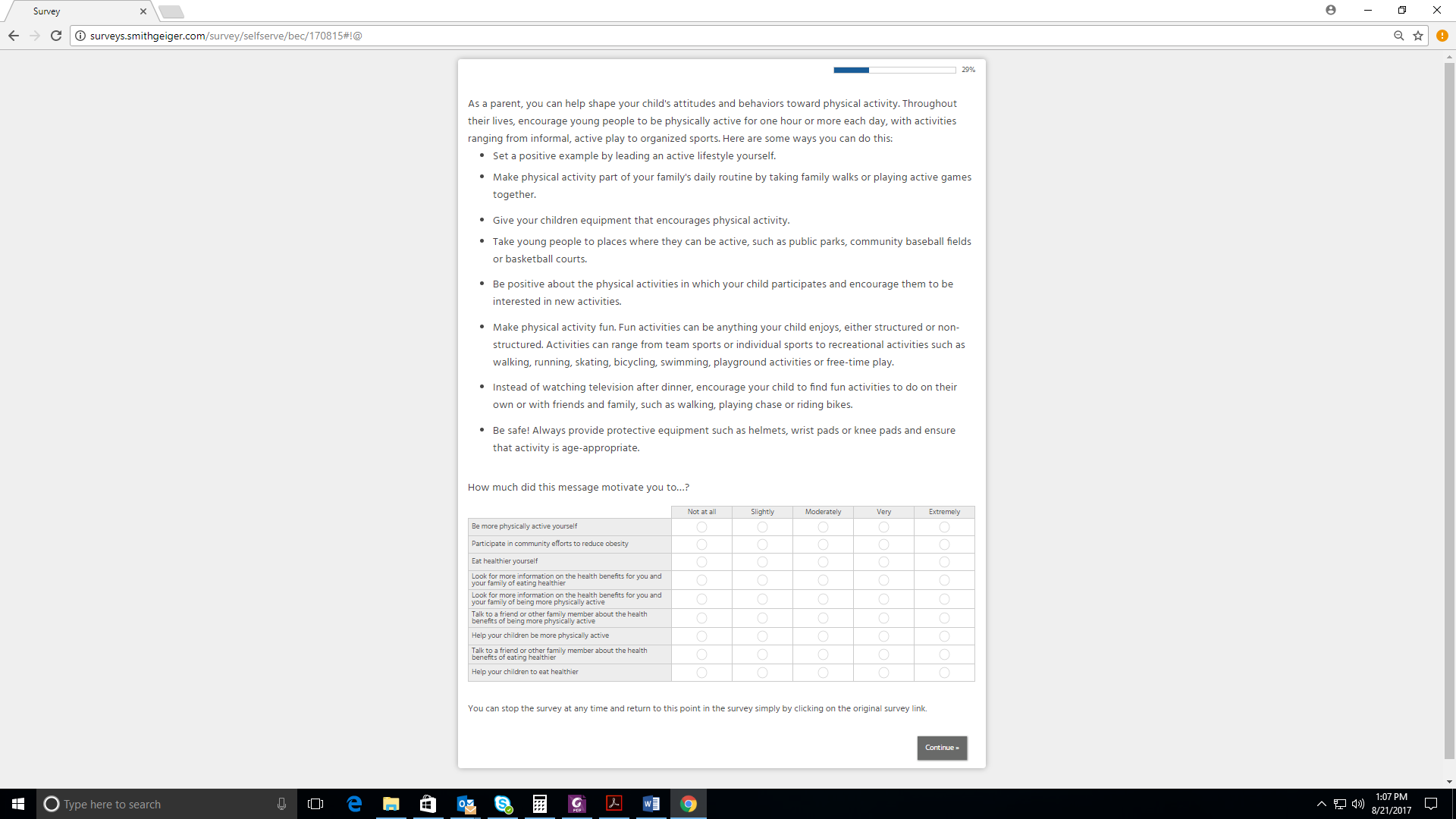
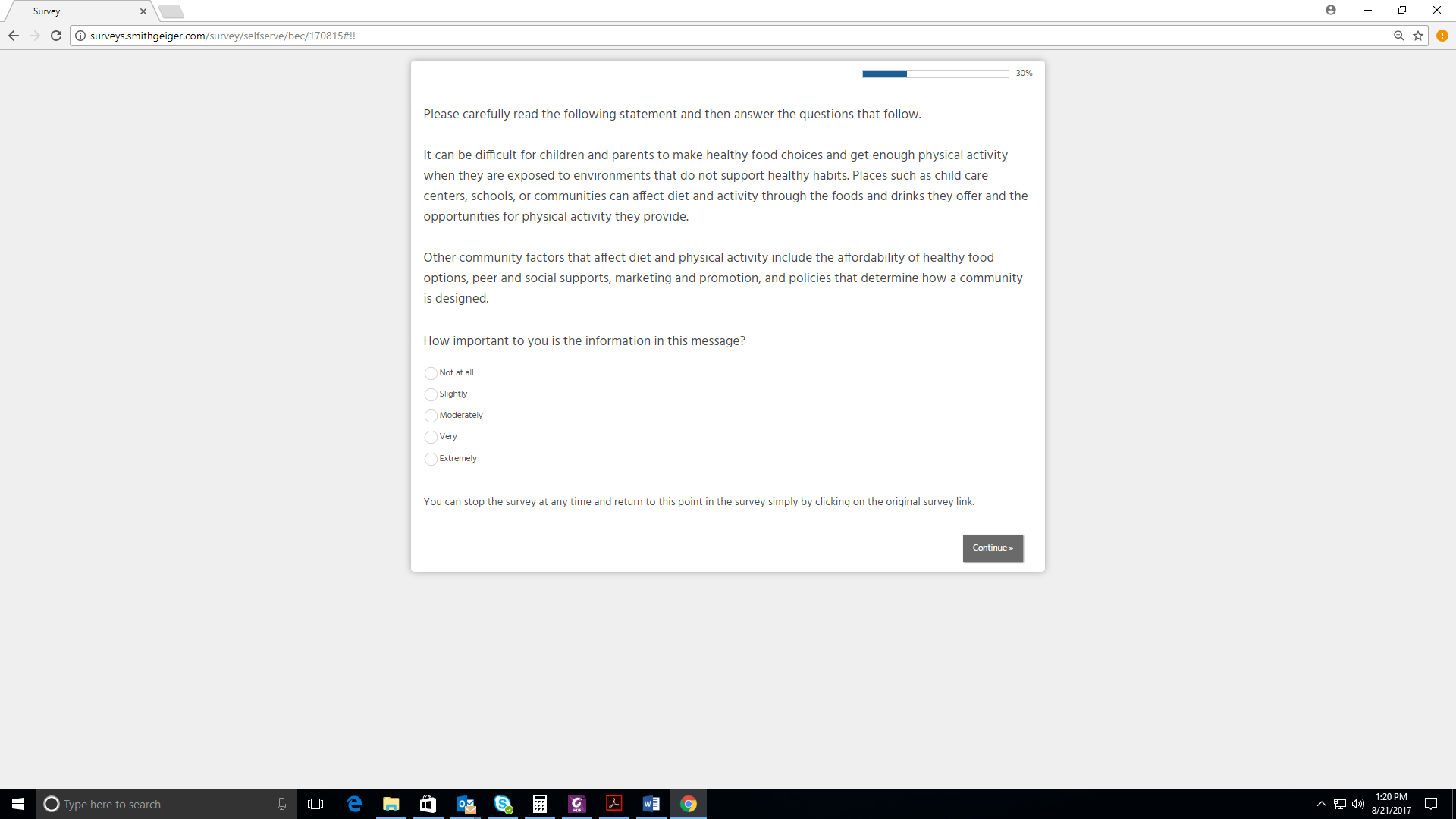

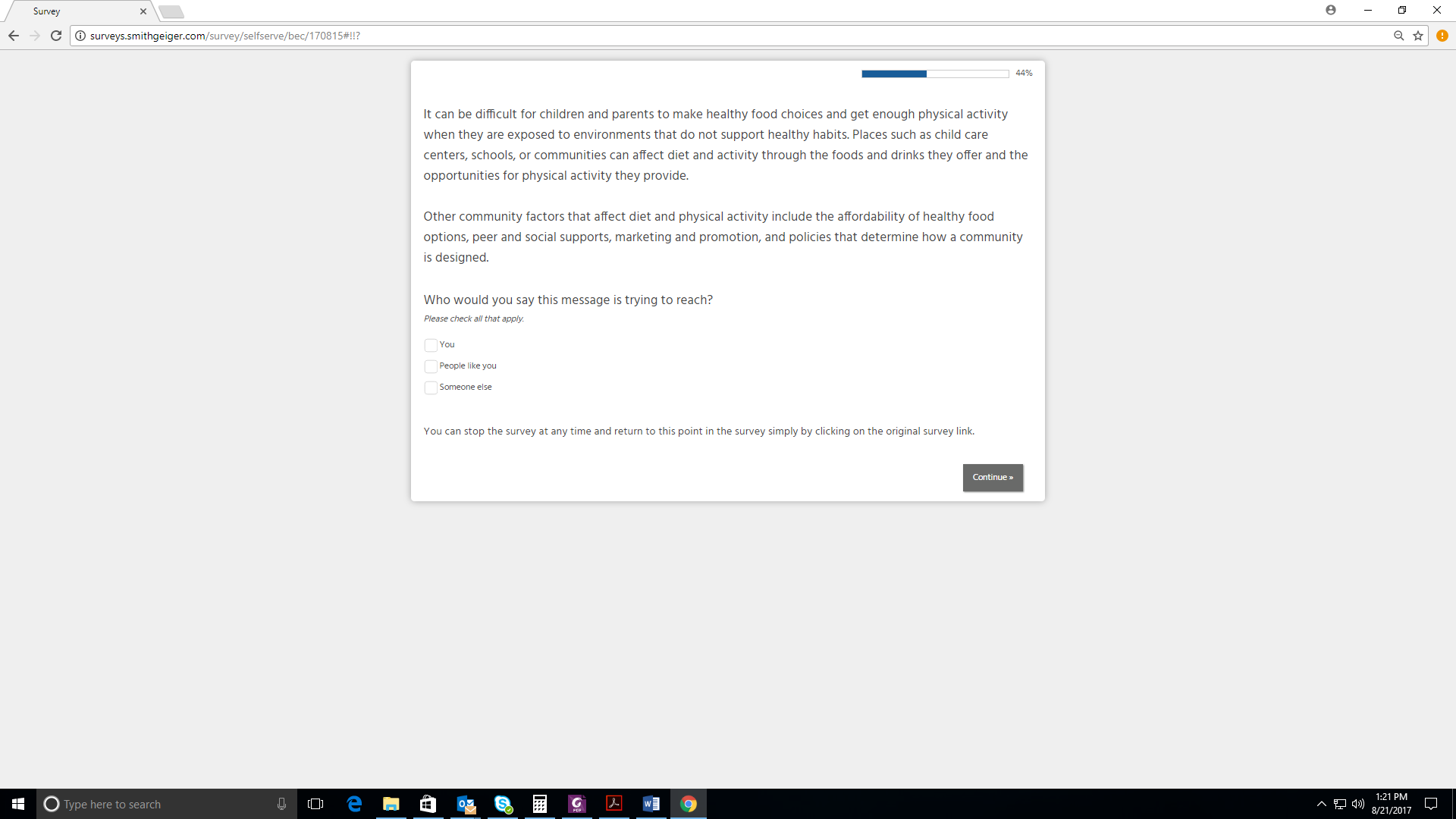
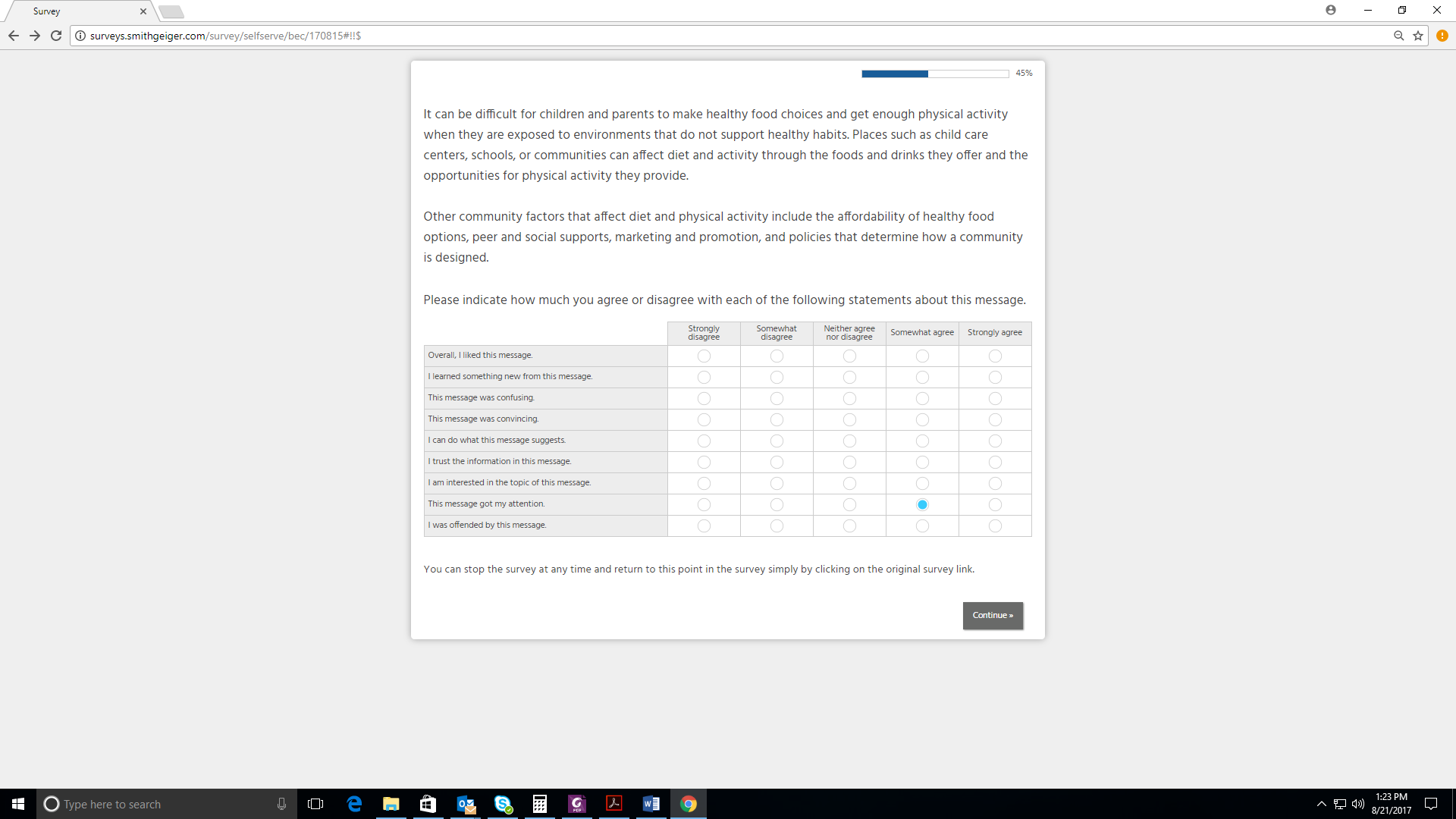
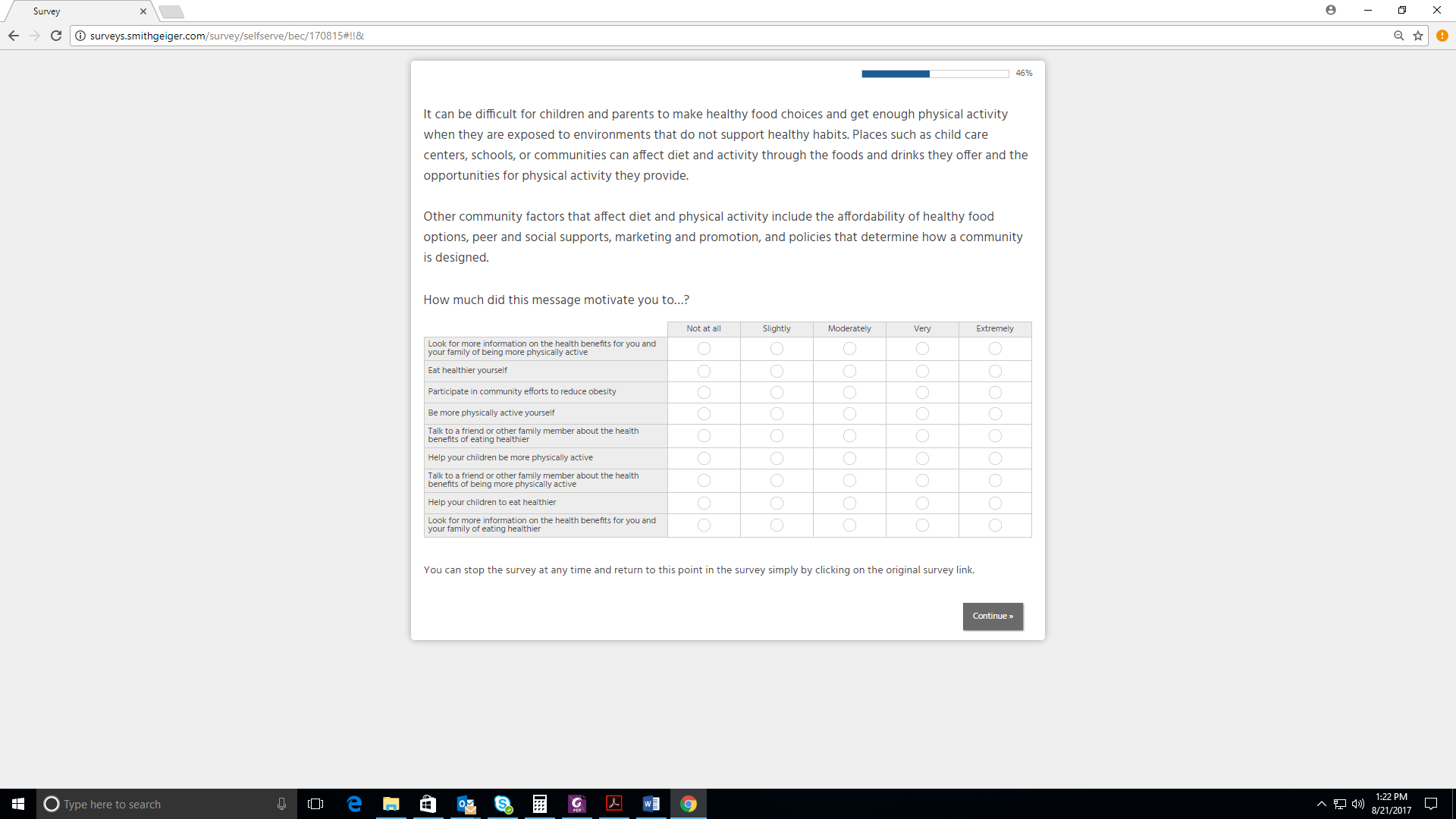
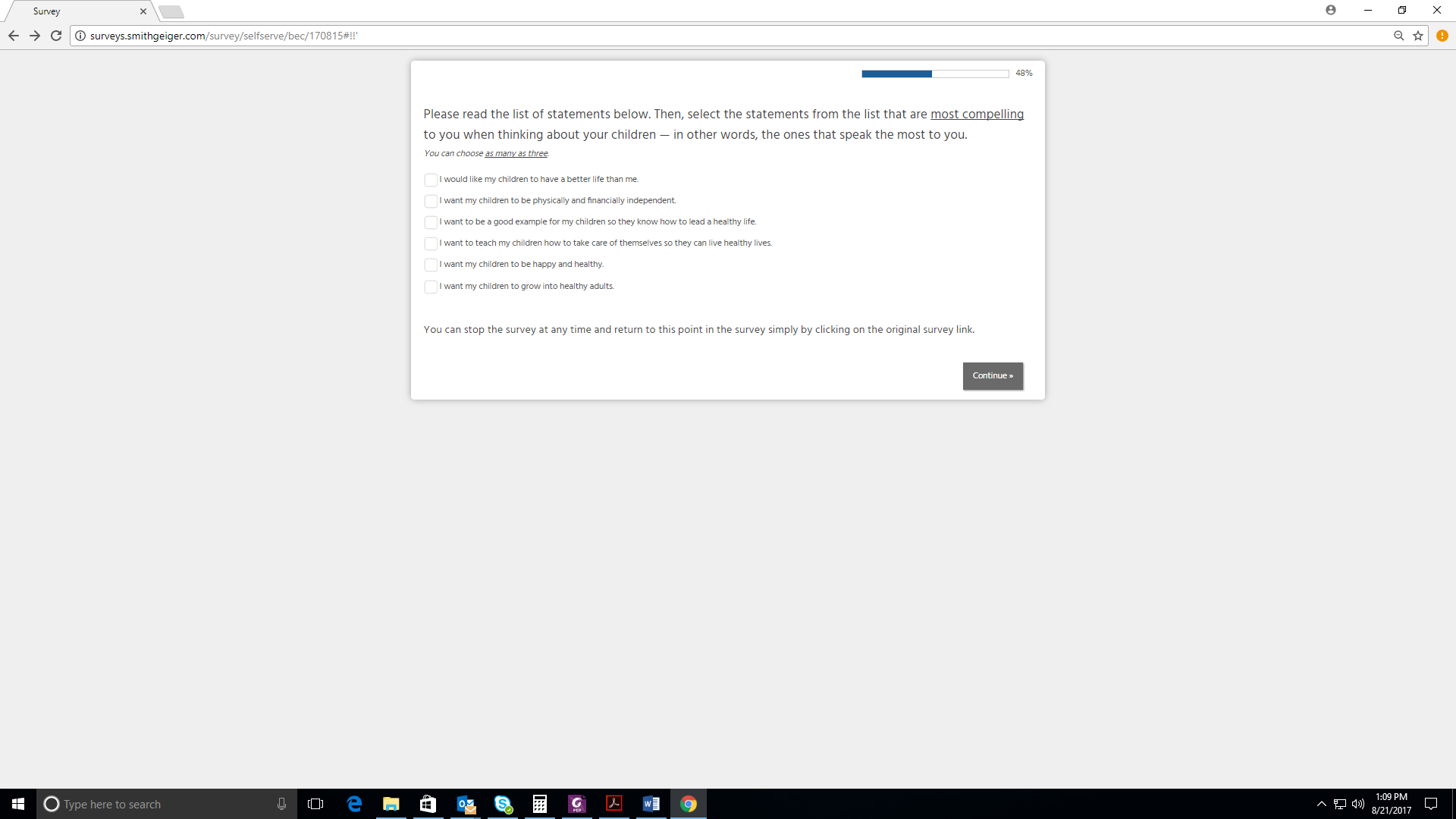
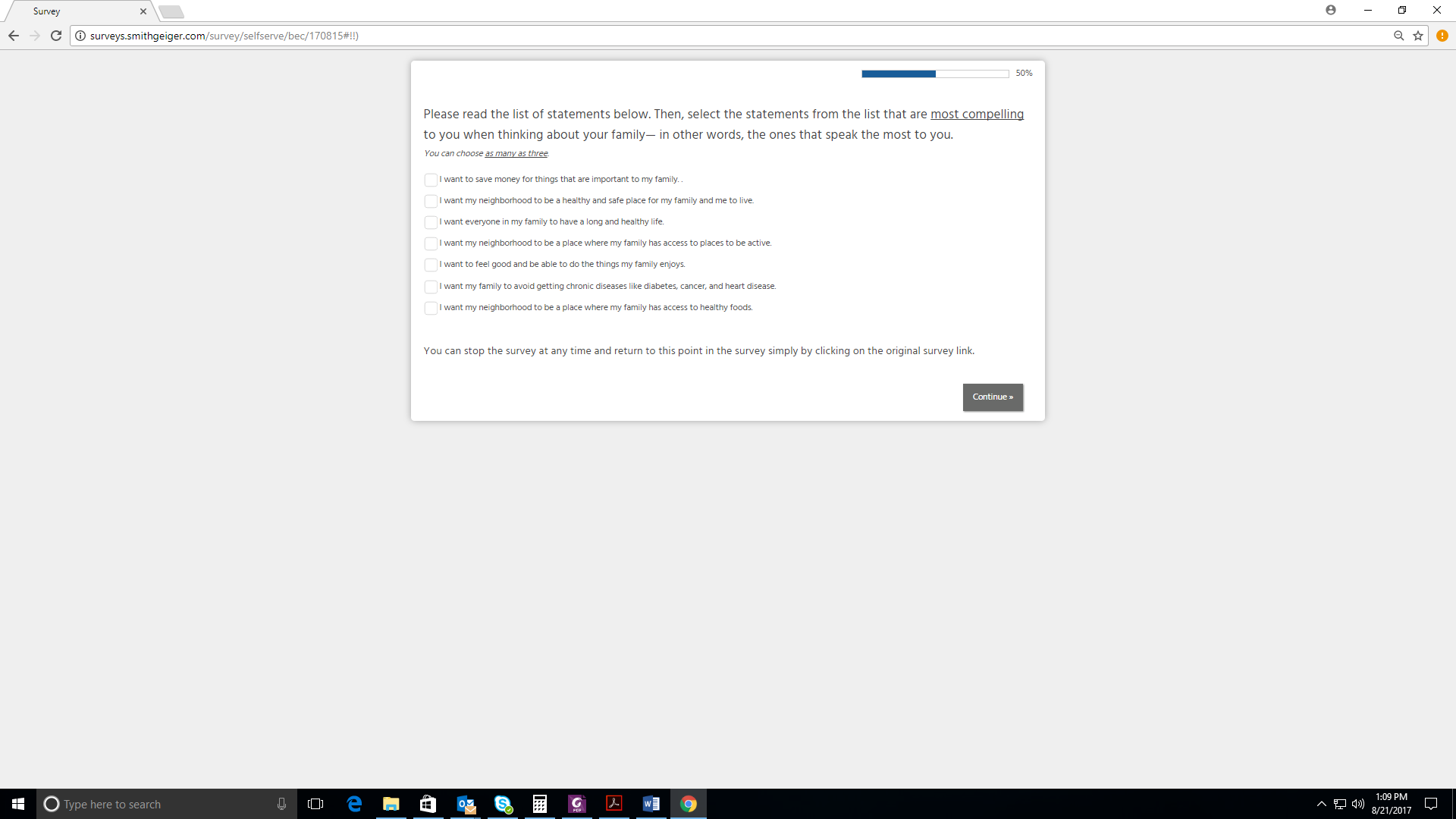

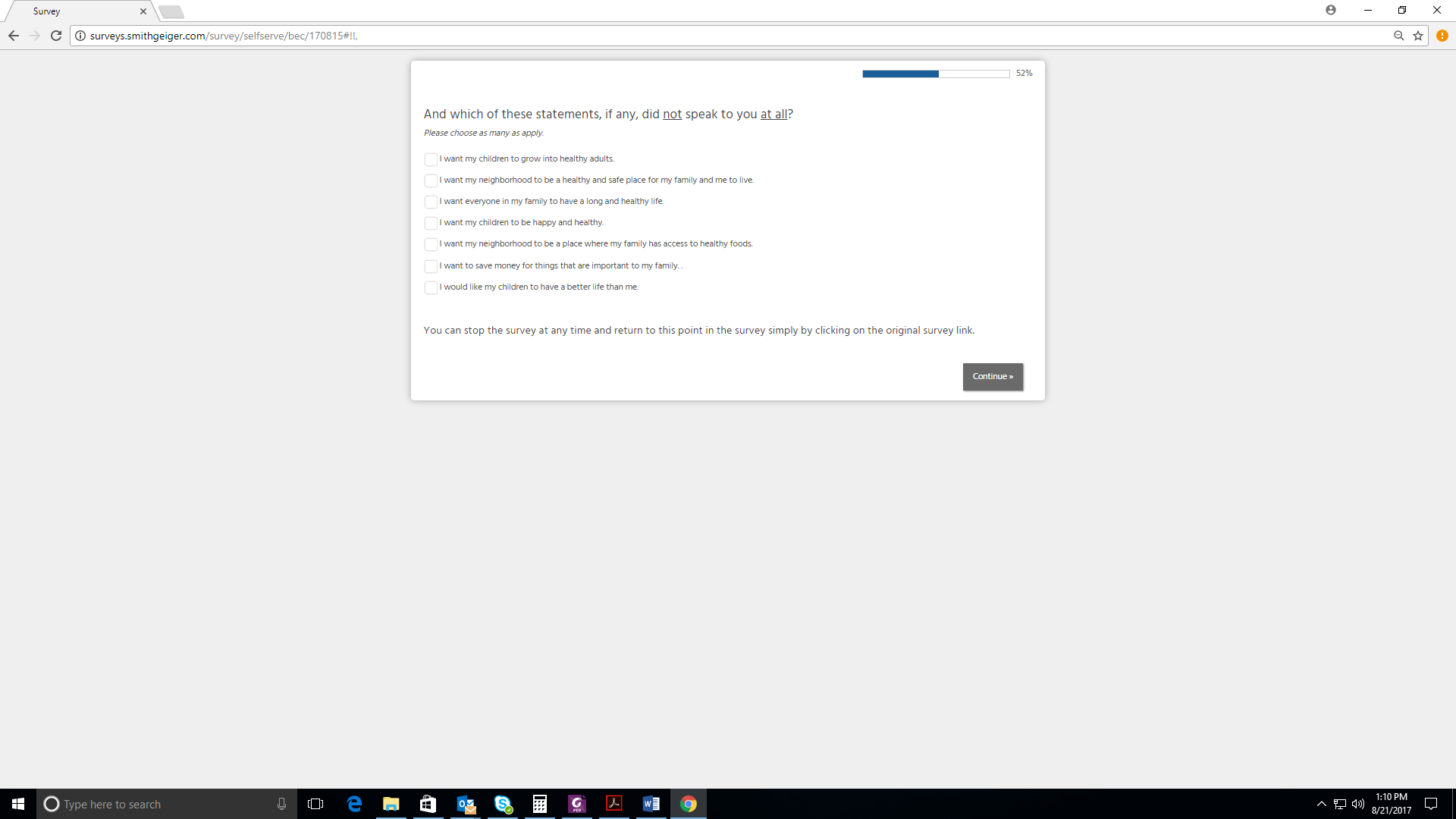

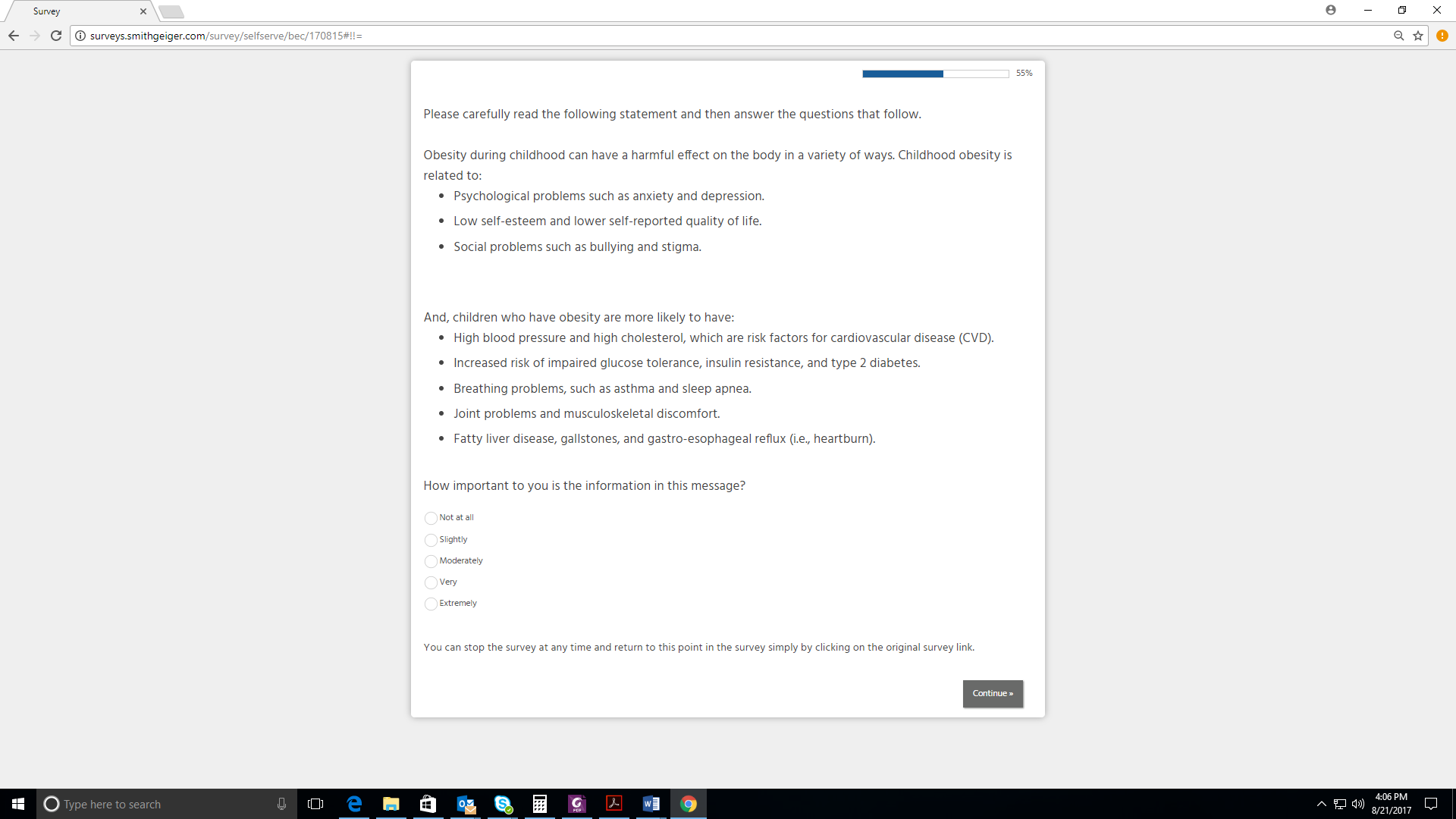
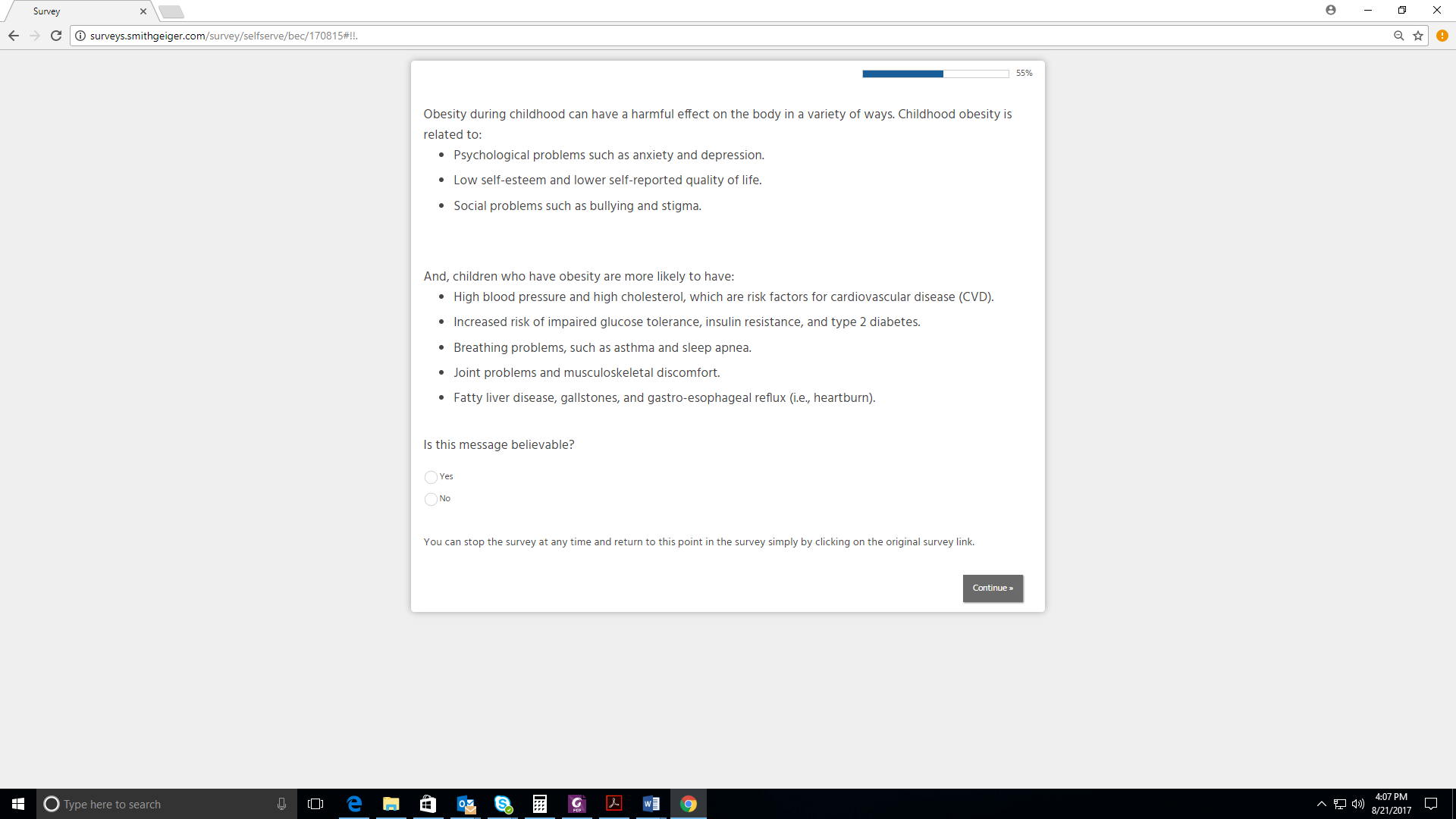
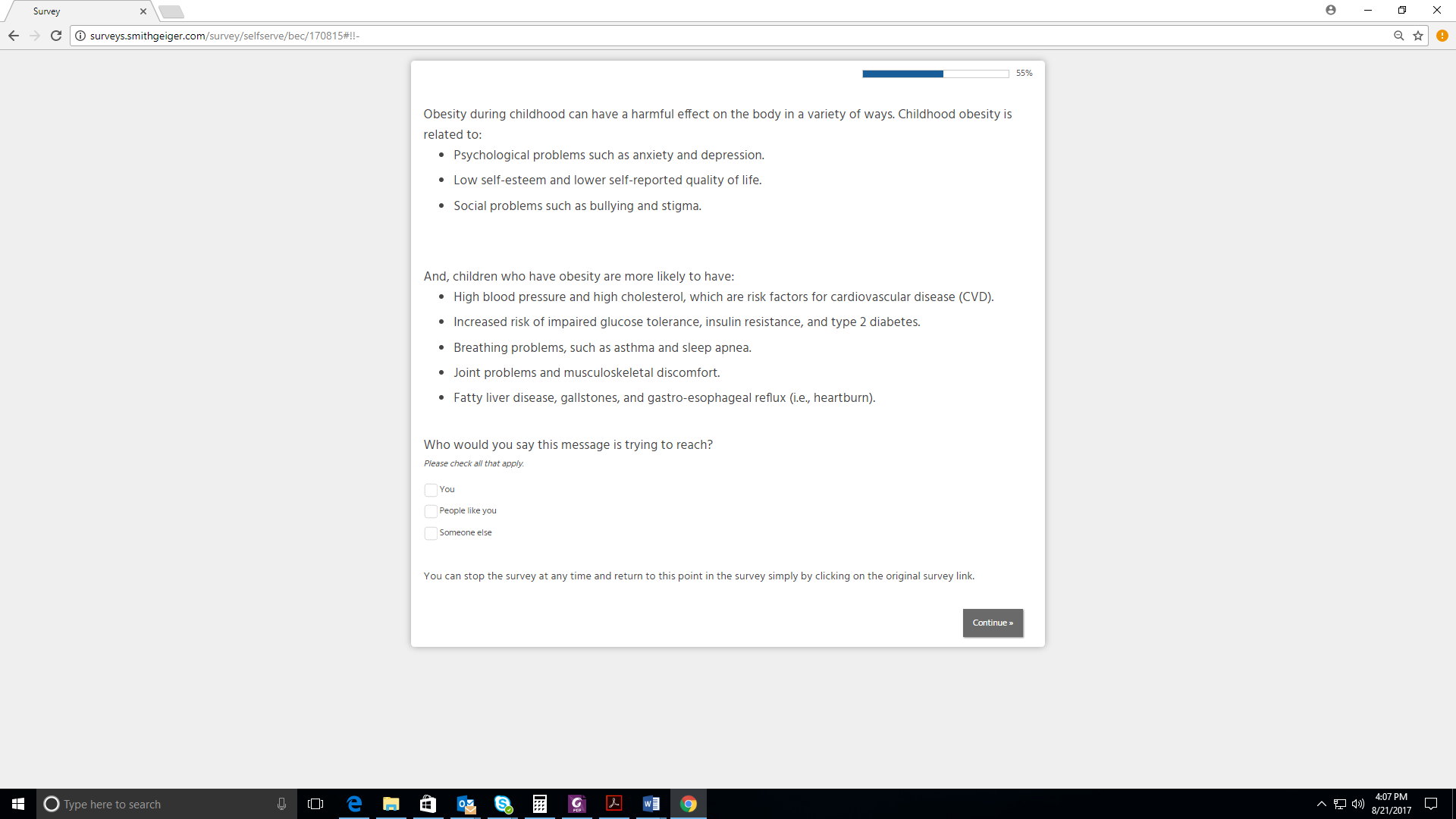
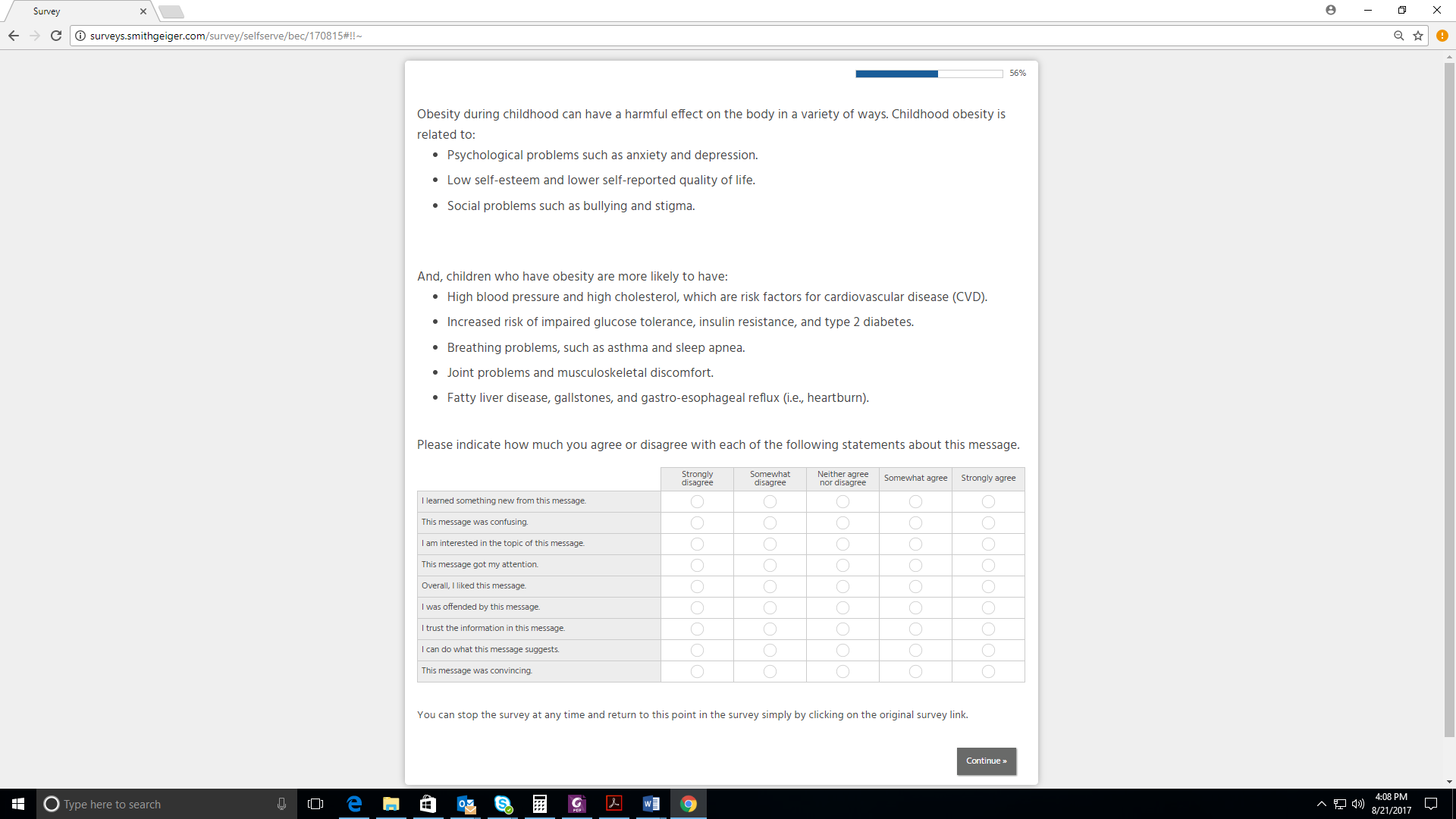

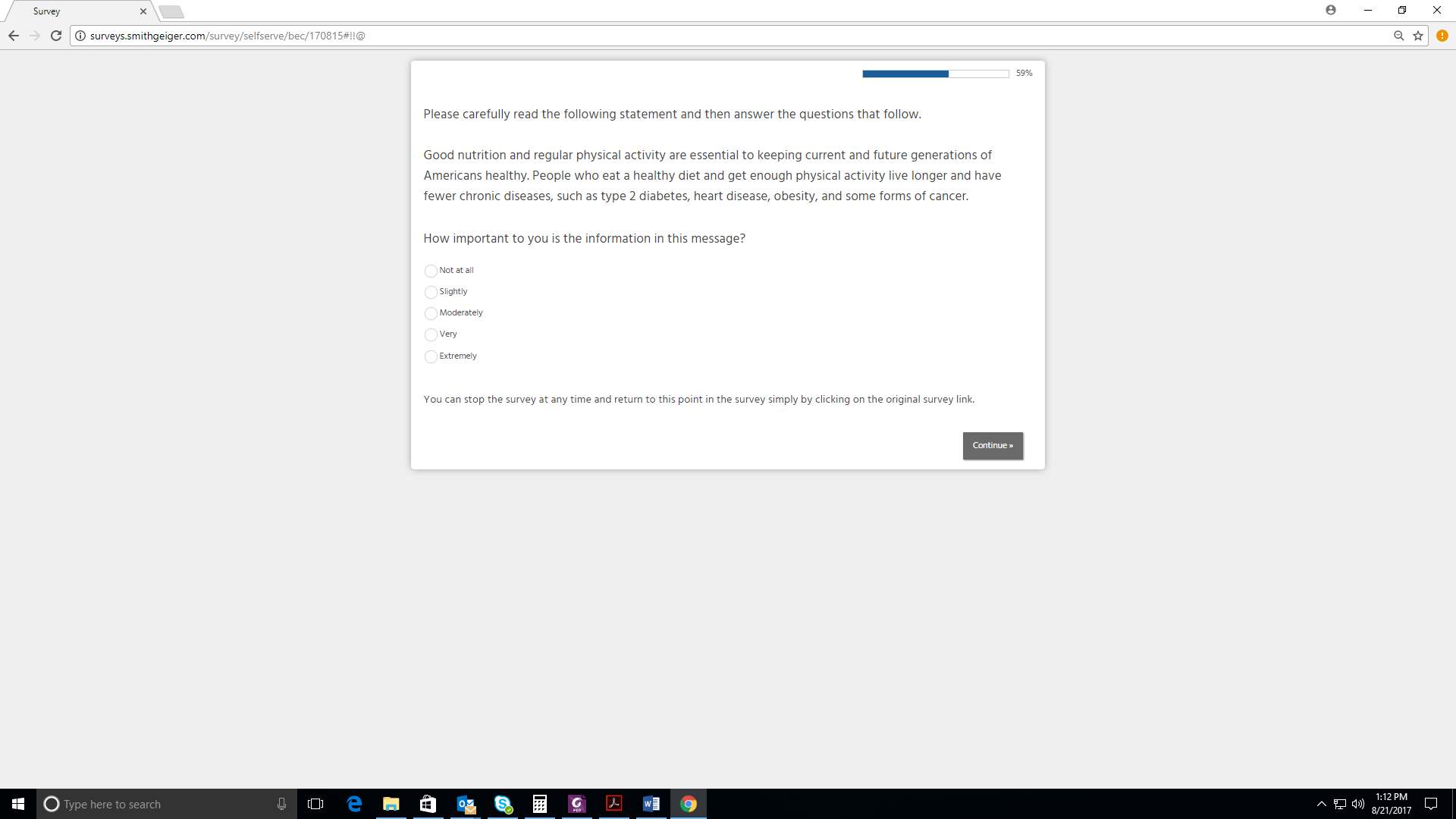


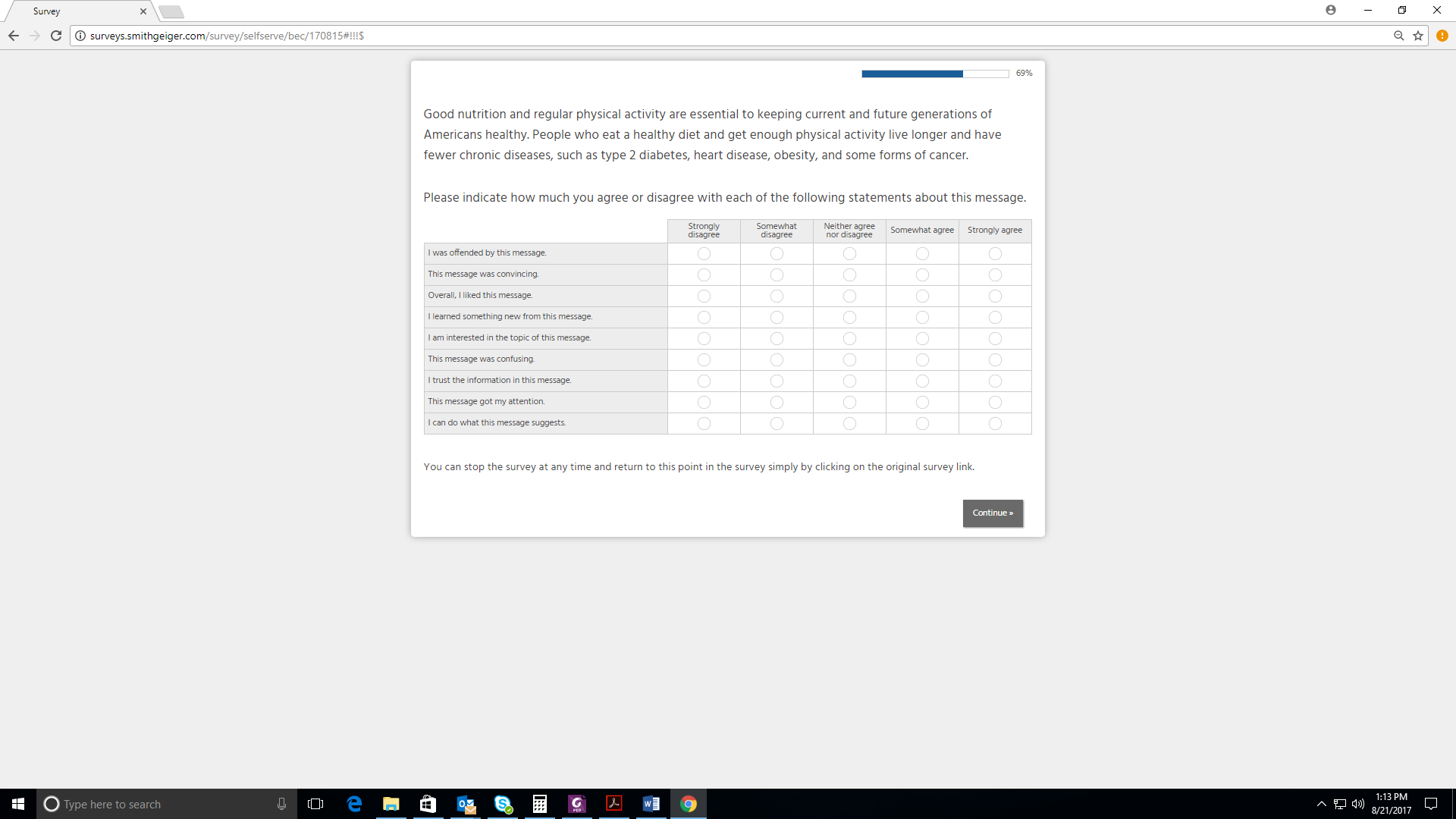
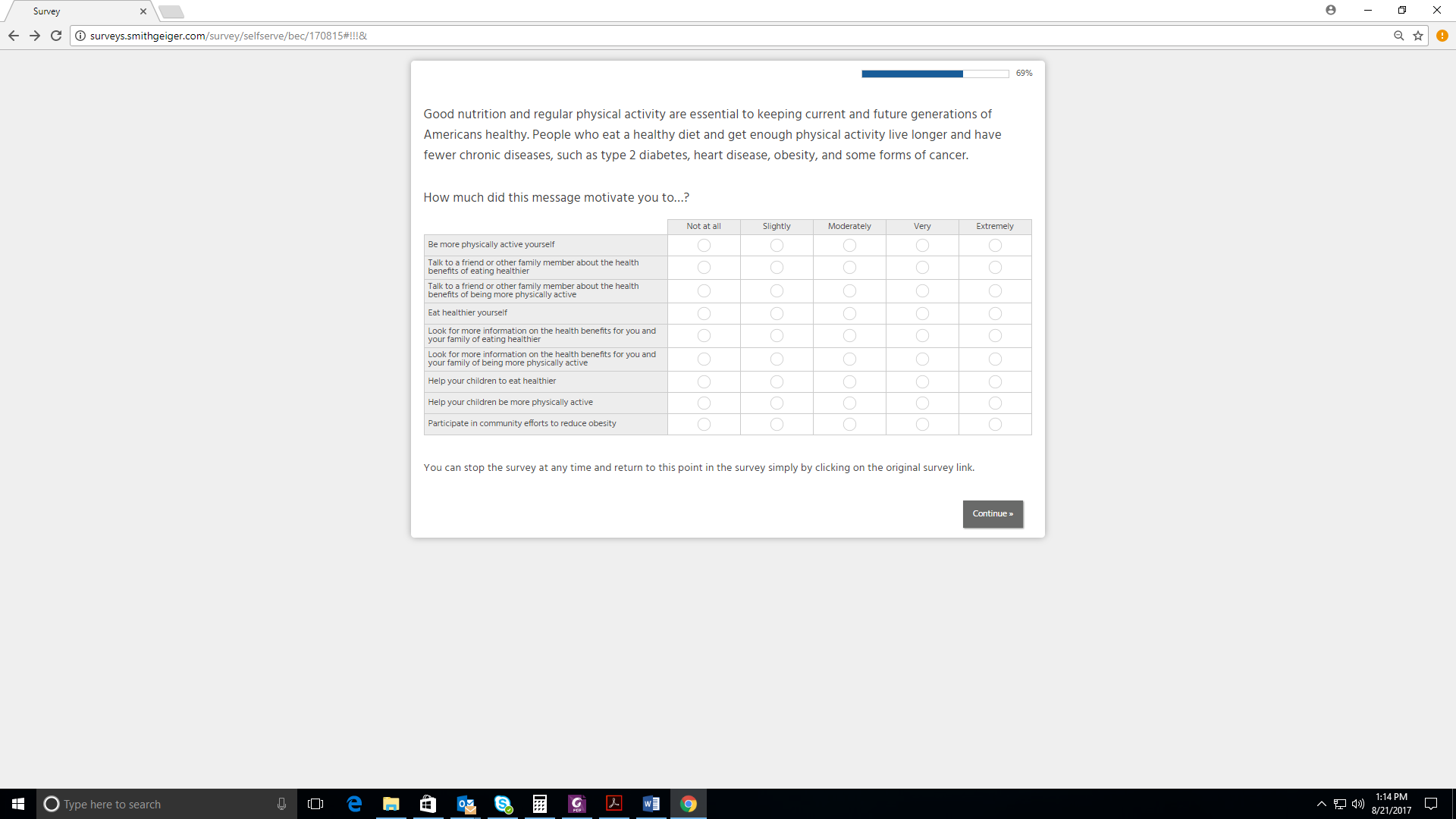

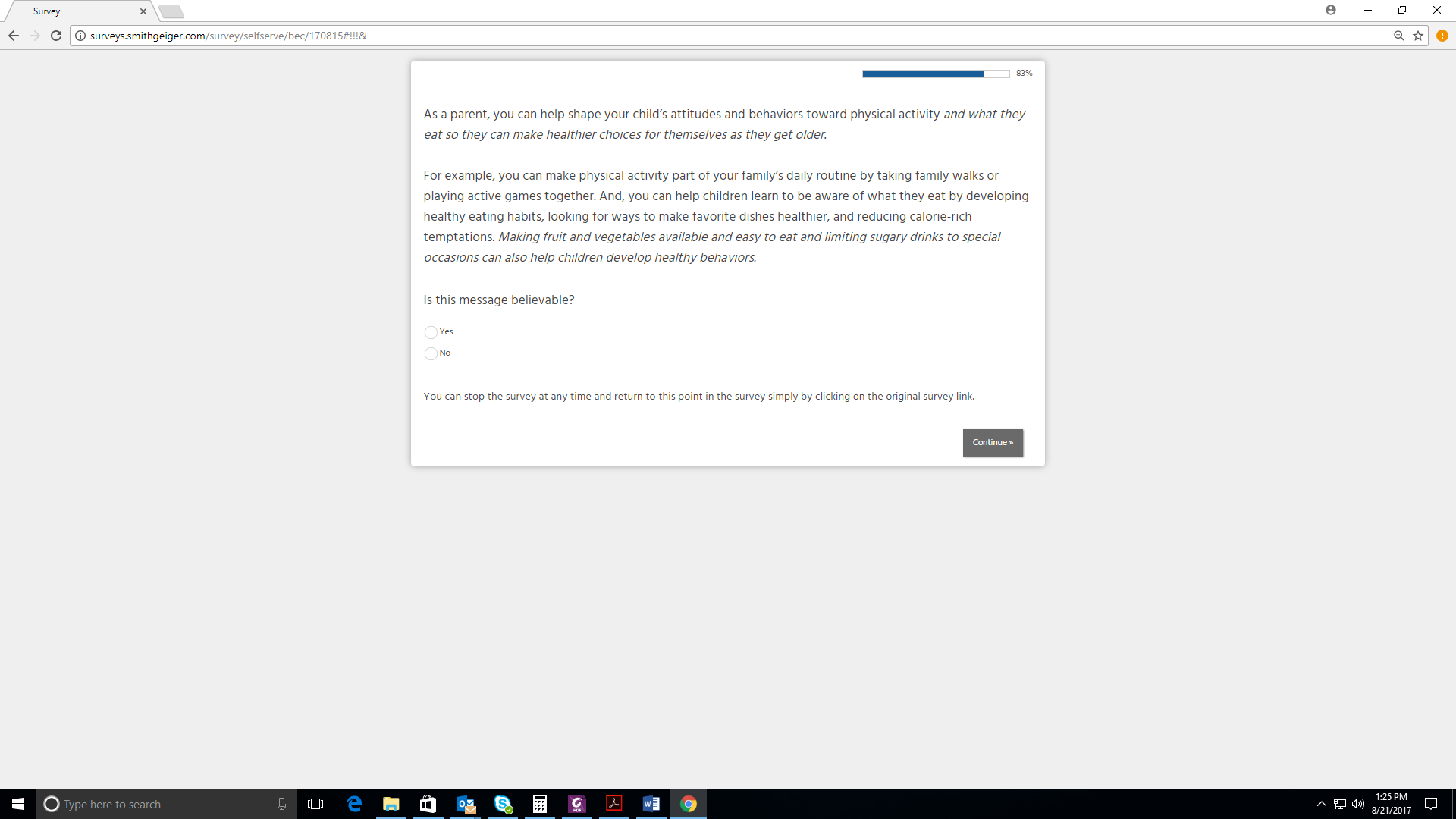
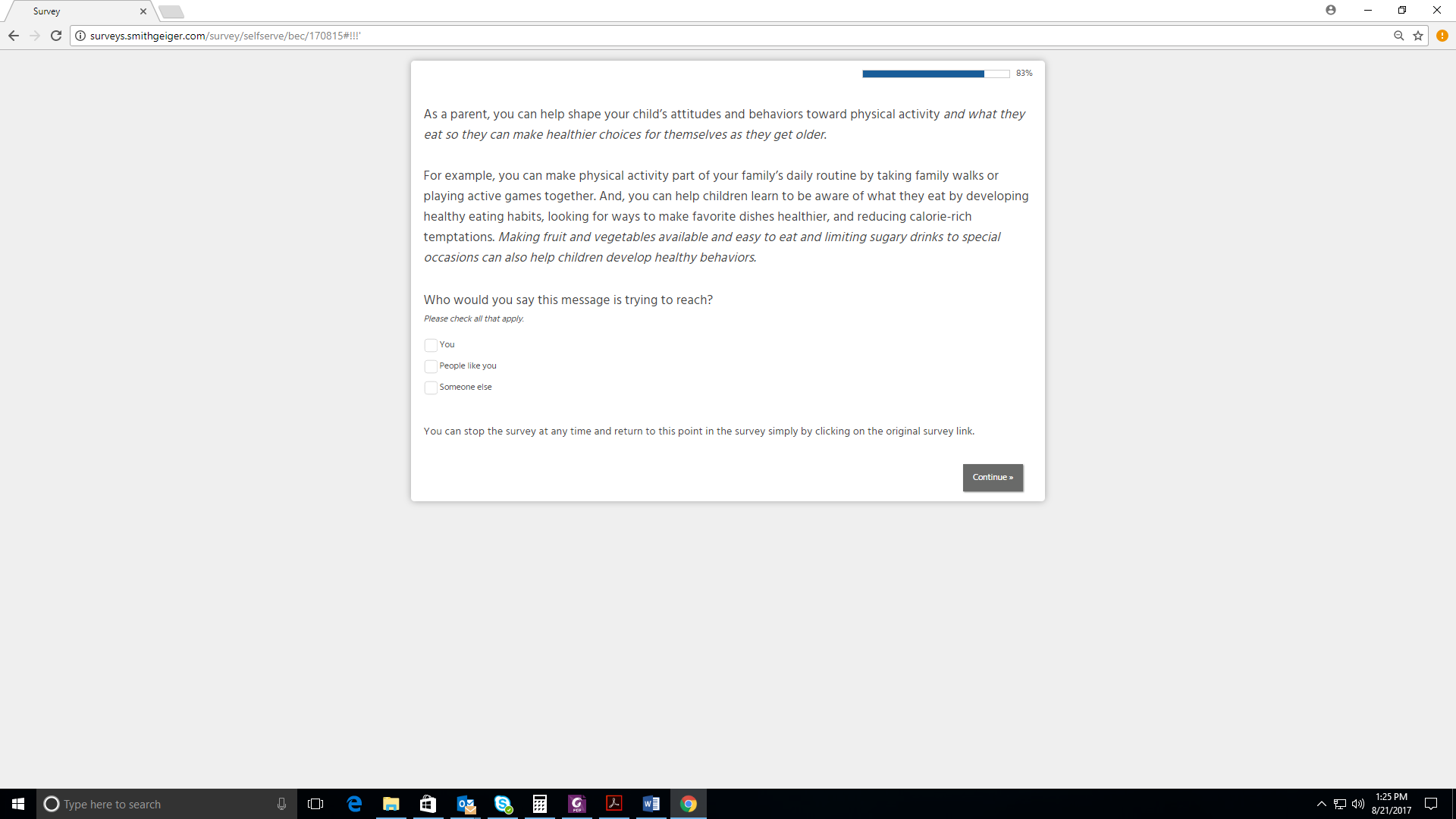
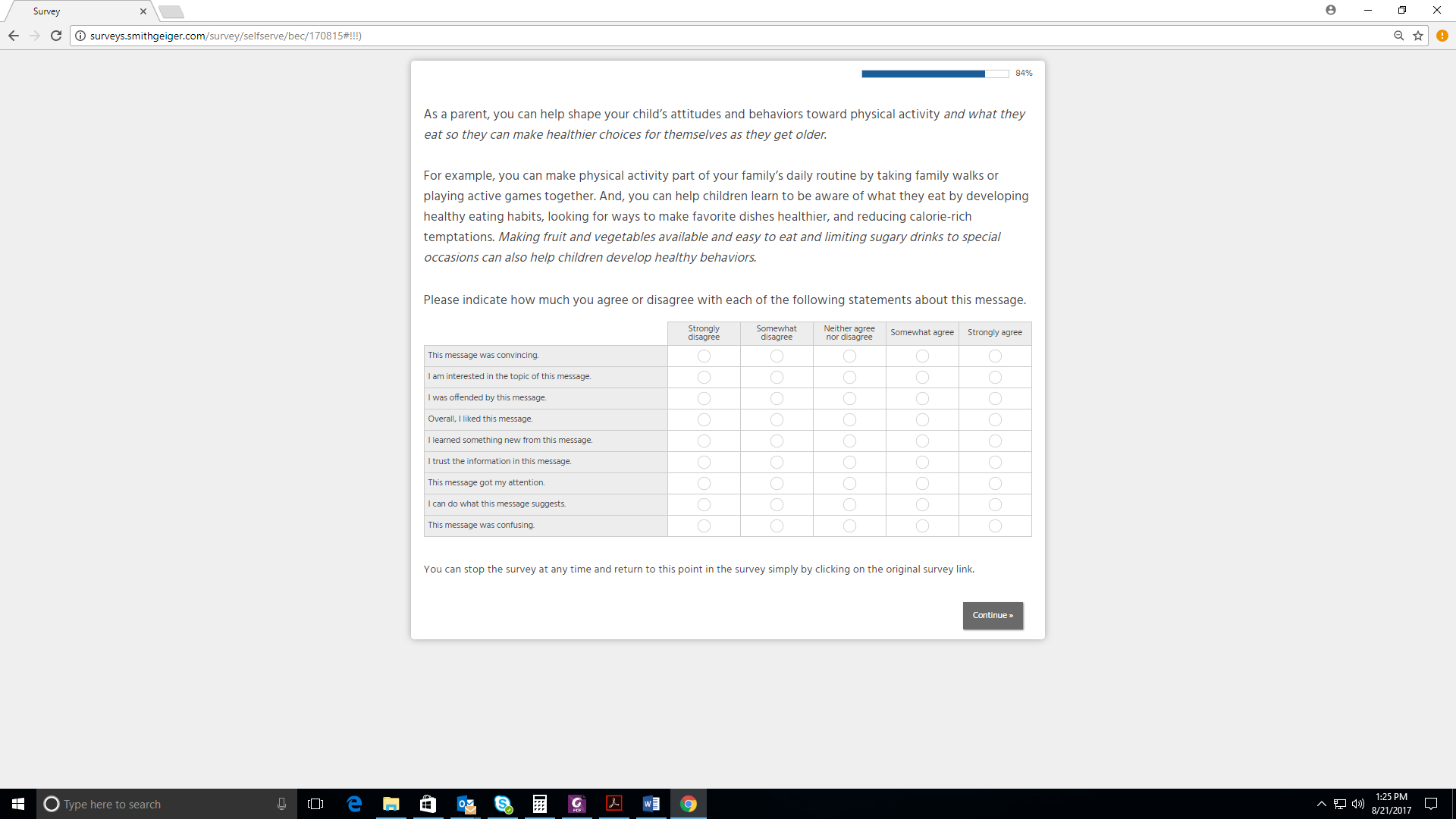


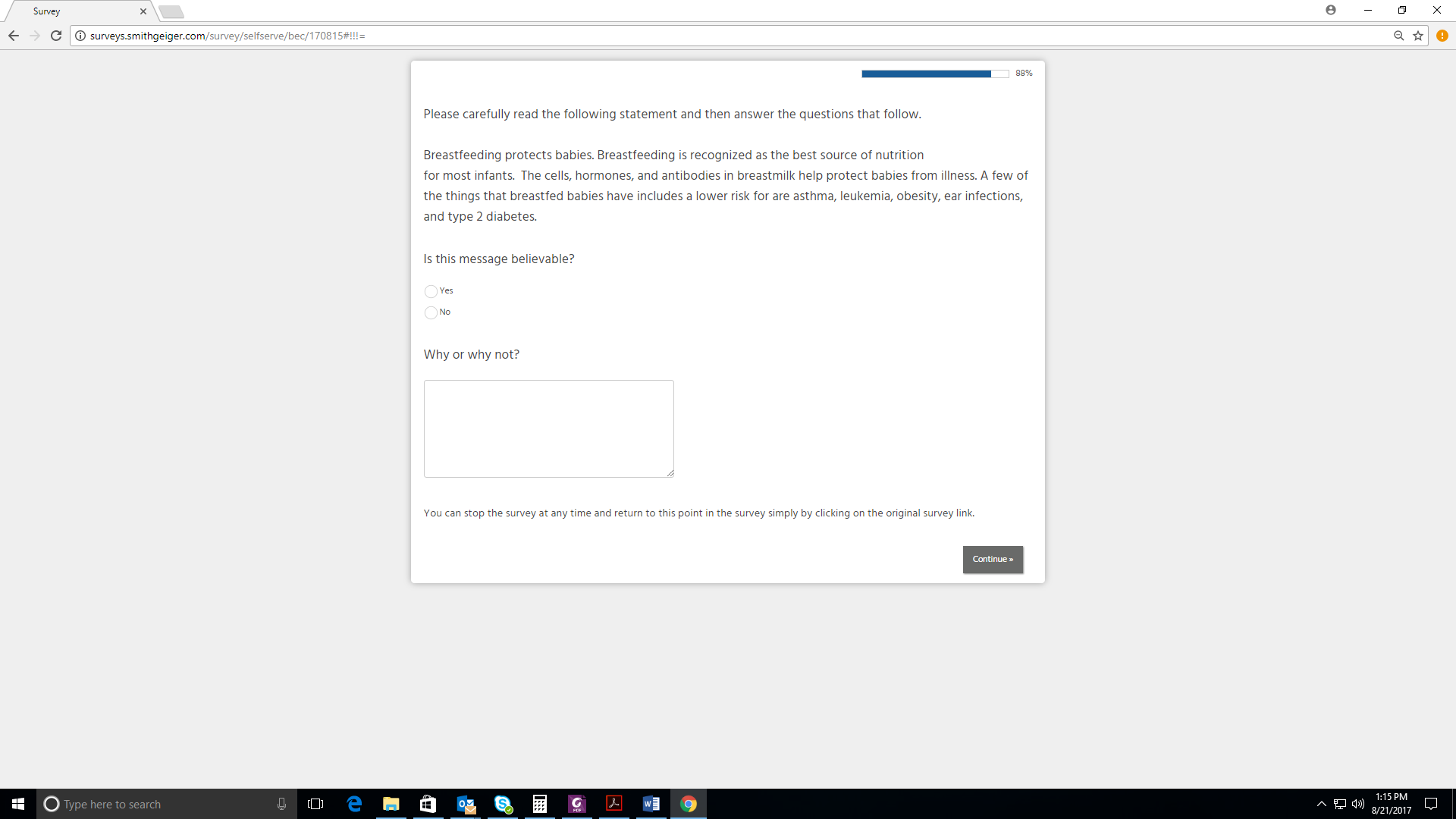
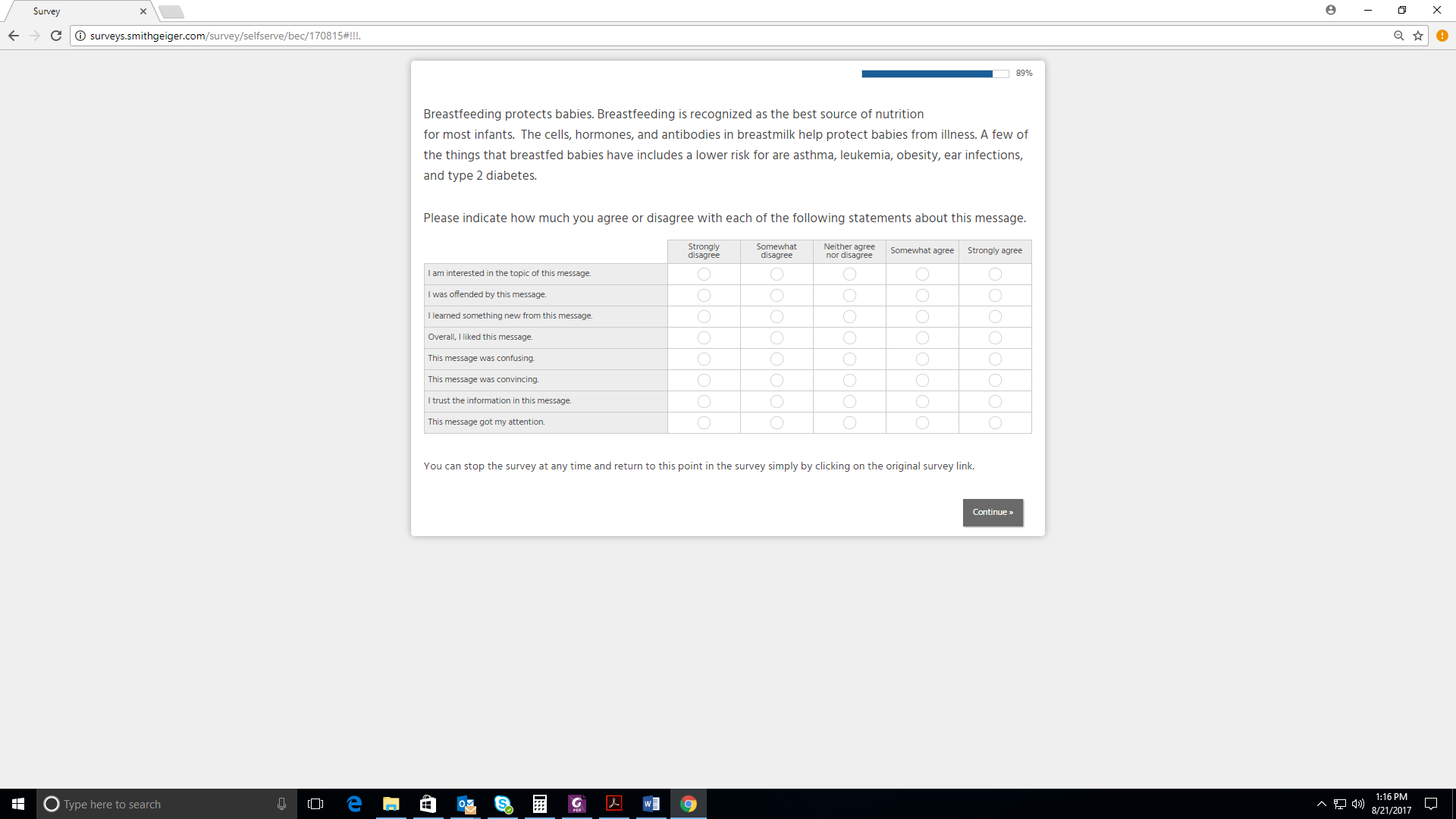
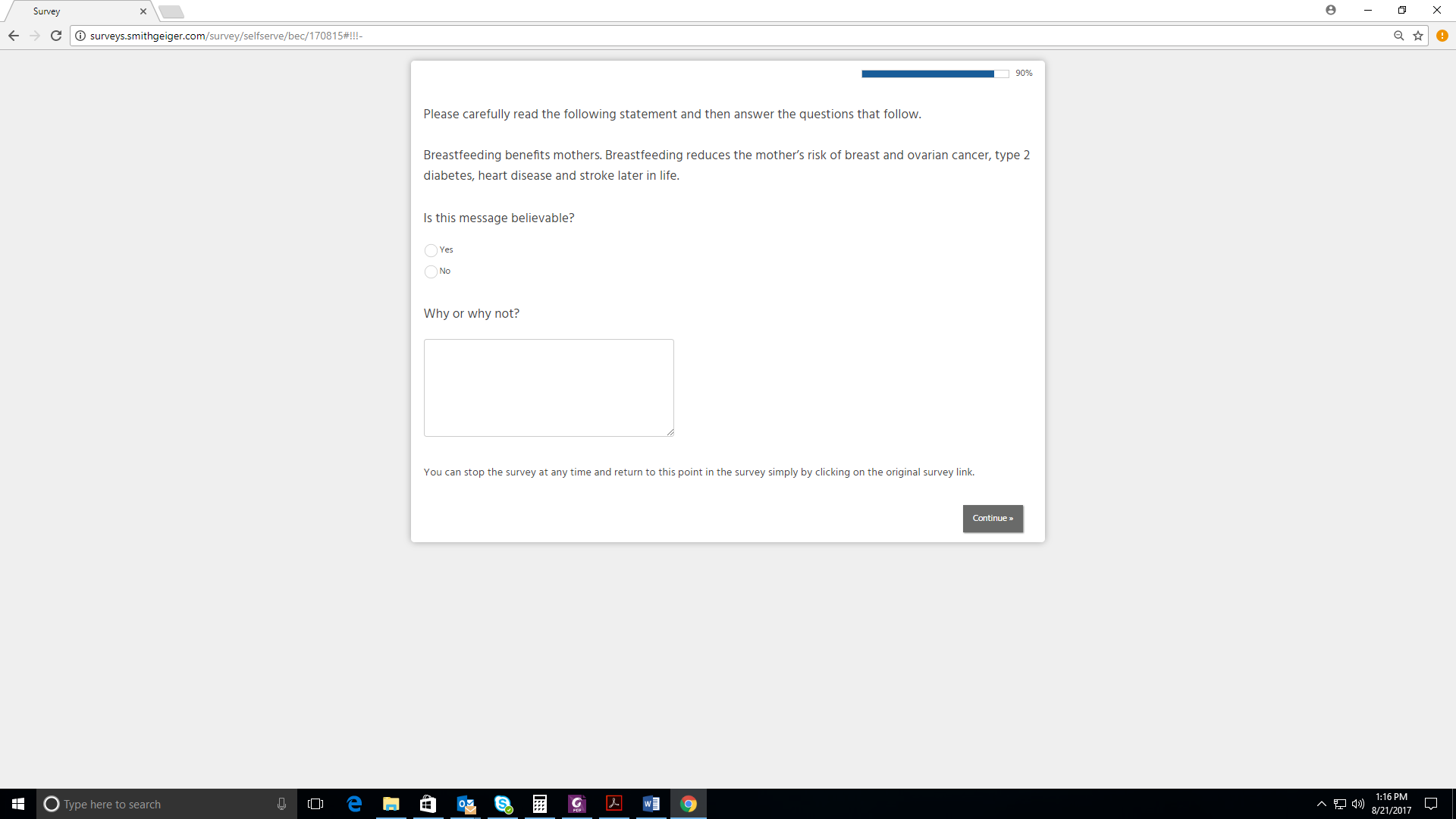
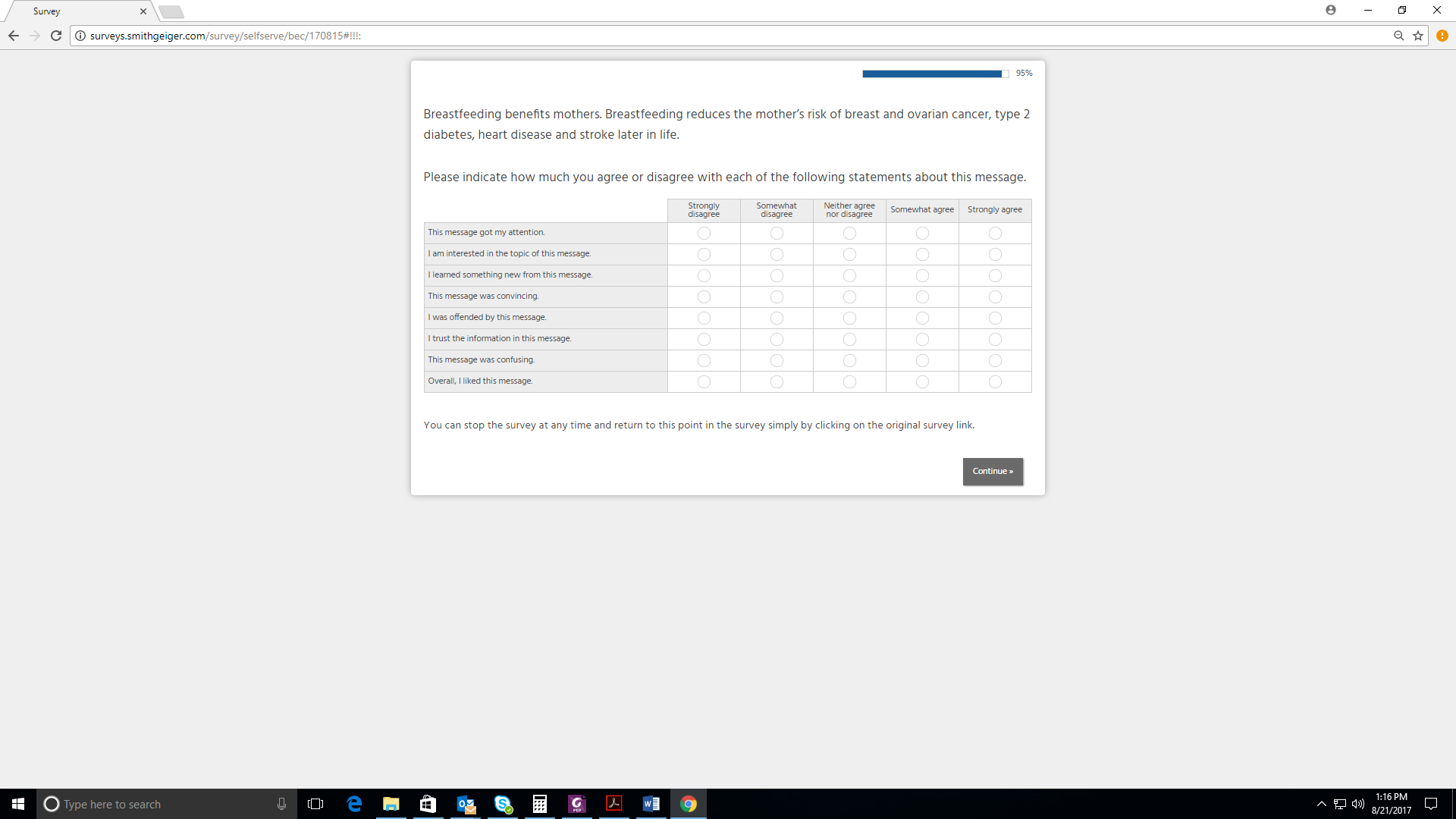


| File Type | application/vnd.openxmlformats-officedocument.wordprocessingml.document |
| Author | lplanas |
| File Modified | 0000-00-00 |
| File Created | 2021-01-21 |
© 2025 OMB.report | Privacy Policy